There have been many different kingdoms over Sri Lanka’s long history. Some of which were set in the unlikeliest of places. A lot of these former kingdoms can still be visited, and it is astonishing to see how advanced some of them were.
Sigiriya is situated in the middle of Sri Lanka. It has a storied past which left behind an interesting palace. Originally formed by a volcano, Sigiriya Rock or Lion’s Rock, is a massive flat-topped rocky outcrop that stands 200m high above the flat jungle. It’s a tall, colourful rectangle with awkward bulges making it very distinguishable. In the 5th century, a king had two sons, one by the first queen and one by a lesser queen. The prince born to the lesser queen, staged a revolt where he killed his father, the king, and took over the reign of his father’s lands. His half-brother fled Sri Lanka in fear of his life, but vowed revenge. The new king chose to put his palace on top of Sigiriya Rock as it offered protection from his brother.
Prehistoric temple caves have been found around at the base of Sigiriya, and apparently some were still used in the 5th century when the new king took over. He moved the cave-dwelling monks to another set of caves on nearby Pidurangala Rock and proceeded to build his palace around the base and on top of Lion’s Rock.

Sigiriya Rock (LIon’s Rock) 
Views around Sigiriya
The king built two large crocodile infested moats around the palace grounds. They are still full of water today, but not crocodiles. Beyond the moats are the Water Gardens which are an elaborately designed network of ponds. During monsoon season, water circulates between the various ponds, moats and an artificial lake via man-made streams and underground pipes. There’s even a fountain that uses gravity to spurt out water. The symmetrical rectangular ponds have brick sides, polished marble or limestone floors and are surrounded by a lush green lawn. There’s a long walkway between the ponds with a gorgeous view of the extraordinary looking Lion’s Rock.

Old entrance gate below Sigiriya Rock 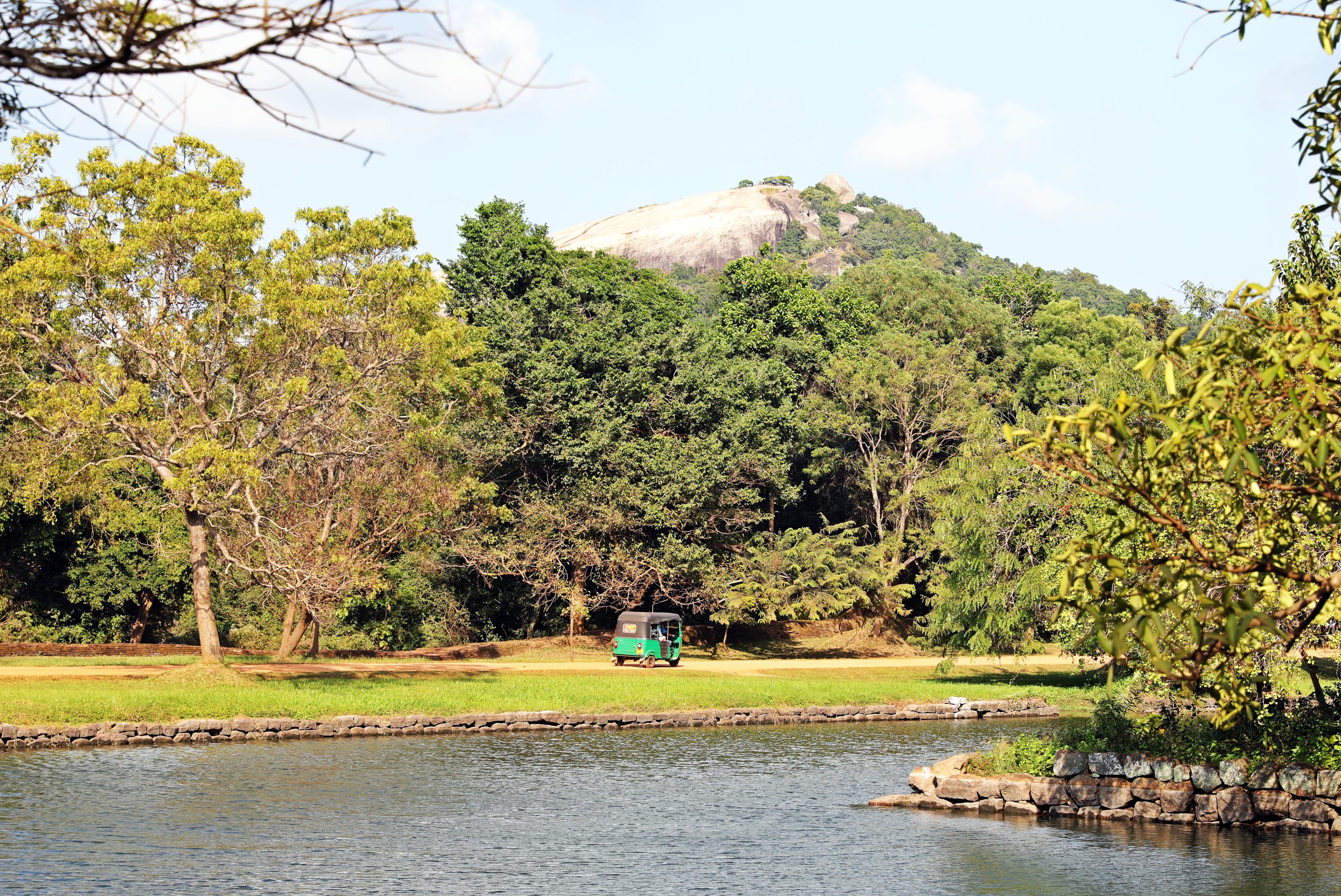
Pidurangala Rock and Sigiriya moat 
Sigiriya Moat 
Water Gardens, Sigiriya 
Water Gardens, Sigiriya 
Water Gardens, Sigiriya 
Sigiriya Rock 
Octagonal Pond, Sigiriya Water Gardens
Beyond the ponds are the Boulder Gardens where enormous rocks have been incorporated into some of the palace structures. Some were used as archways, others as caves including the very tall Cobra Hood cave. On the flat tops of other boulders are the floors of rooms such as the king’s audience hall with a stone throne. It used to have wooden walls and a roof, but all that remains is the carved floor plan. Nearby, another boulder has a deep cistern carved into its top. There’s a magical atmosphere walking on the winding pathway through these massive boulders with the impressive rock feature of Sigiriya looming above.

Boulder Arch, Boulder Gardens, Sigiriya 
Boulder Gardens, Sigiriya 
Arch, Boulder Garden, Sigiriya Rock 
Audience Hall, Boulder Gardens 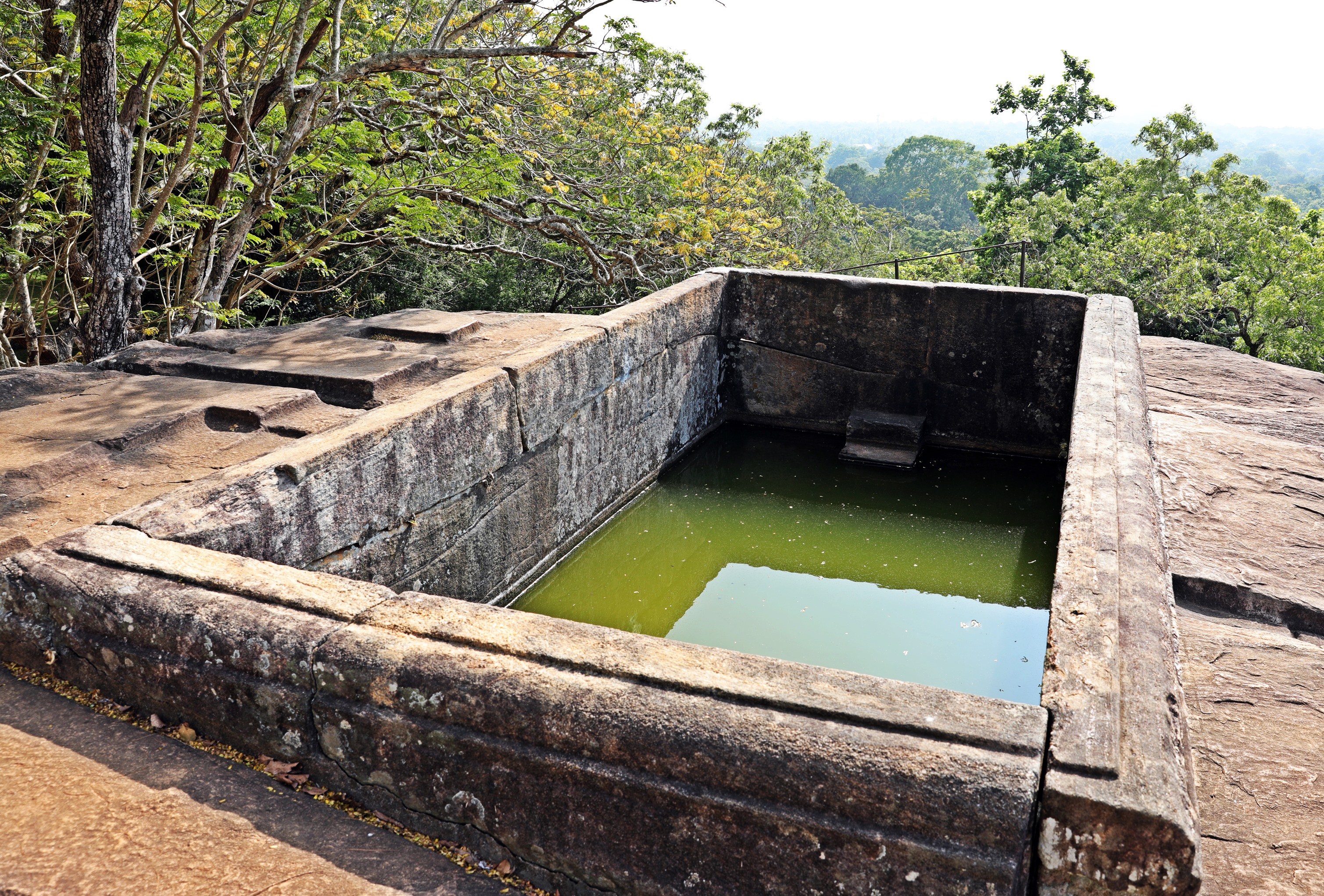
Water cistern, Boulder Gardens 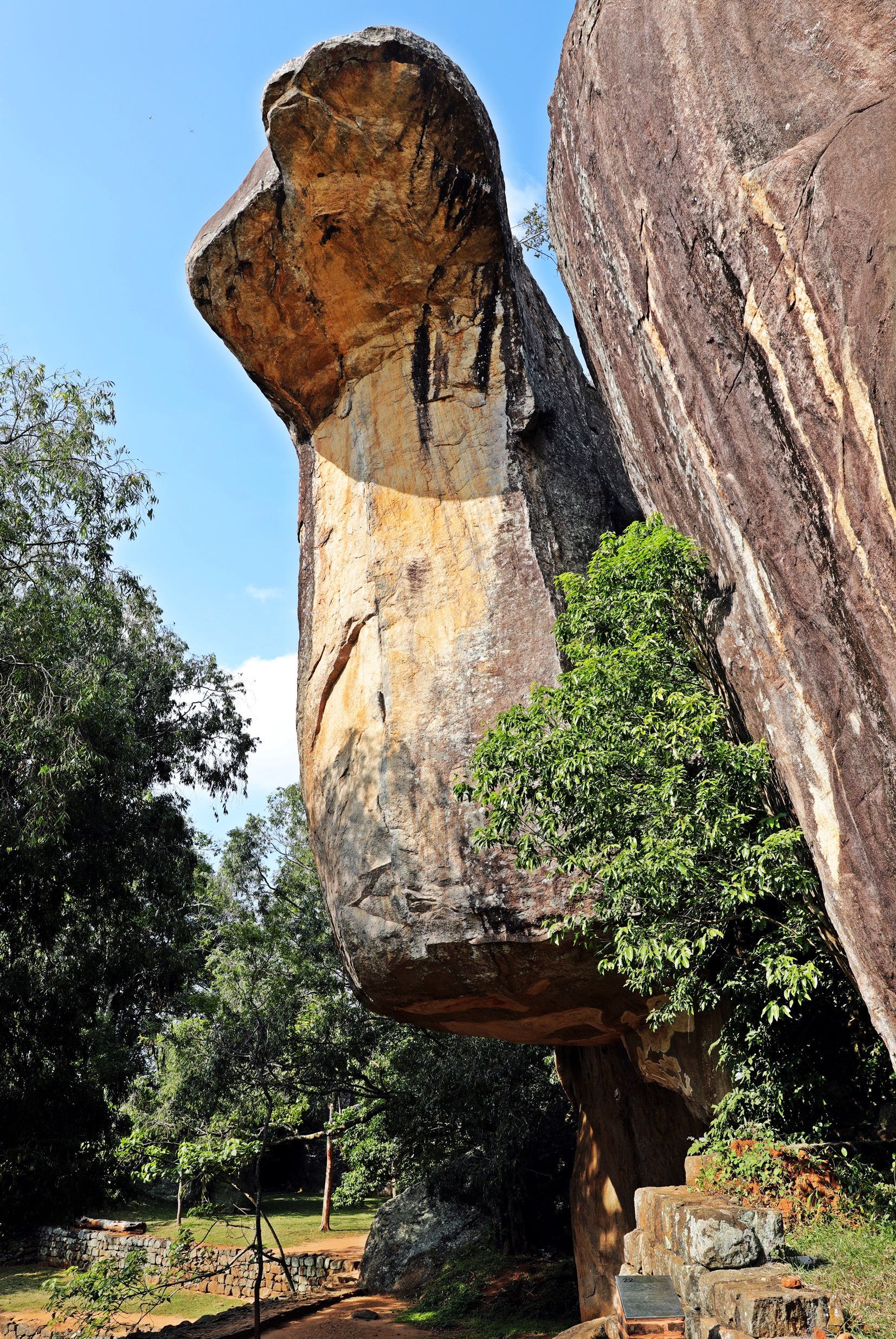
Cobra Hood Cave, Sigiriya Rock
Today there are metal and cement stairs leading up the side of Lion’s Rock, but you can see places where ancient steps were carved into the rock. In the middle of Lion’s Rock, high above the ground is a protected alcove. Inside are incredible 5th century frescos of large breasted, slim waisted women – the first barbie-doll ideal! Historians say they are either depictions of the king’s consorts or celestial nymphs. Apparently, the entire wall used to be covered in these frescoes, but only a few that have been protected from the elements remain. The final steps to the palace used to be through a gigantic lion statue. Only the paws remain but from them you can see the skill of the sculptors. There were many Toque Macaques playing in the small plateau near the paws.
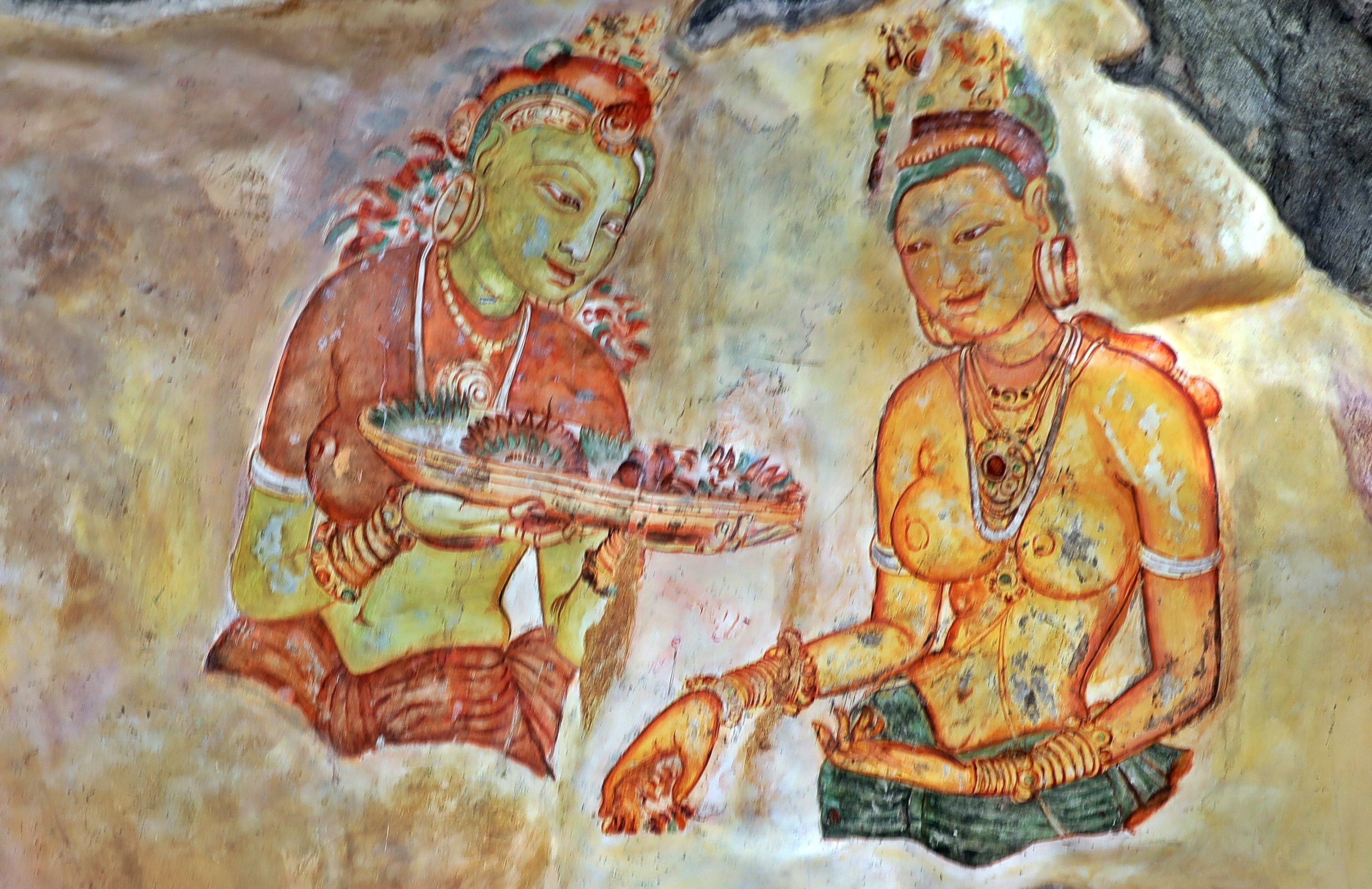
Frescoes, Sigiriya Rock 
Frescoes, Sigiriya Rock 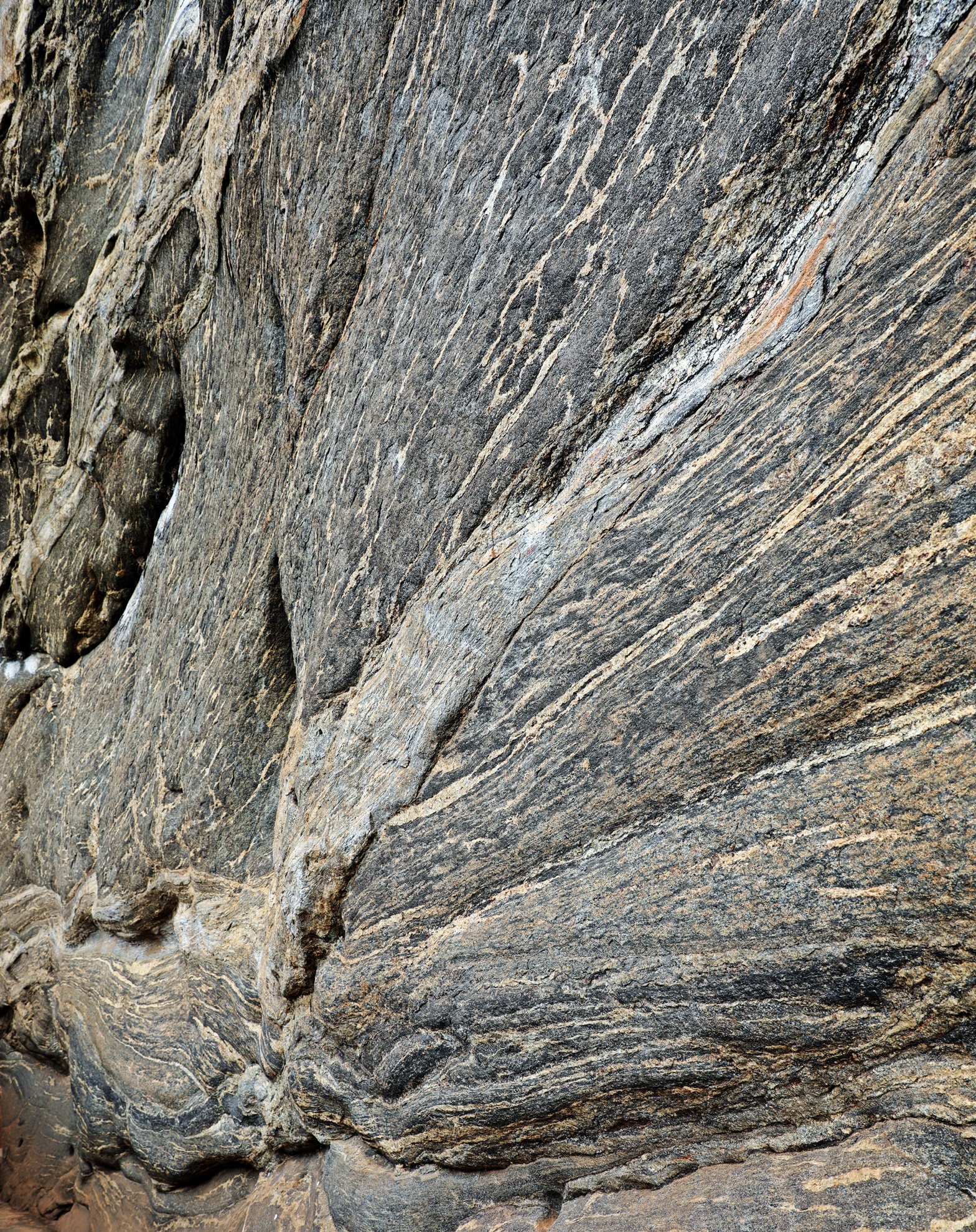
Mirror Wall, Sigiriya 
Steps chiseled into the rock, Sigiriya Rock 
Macaques play fighting, Sigiriya 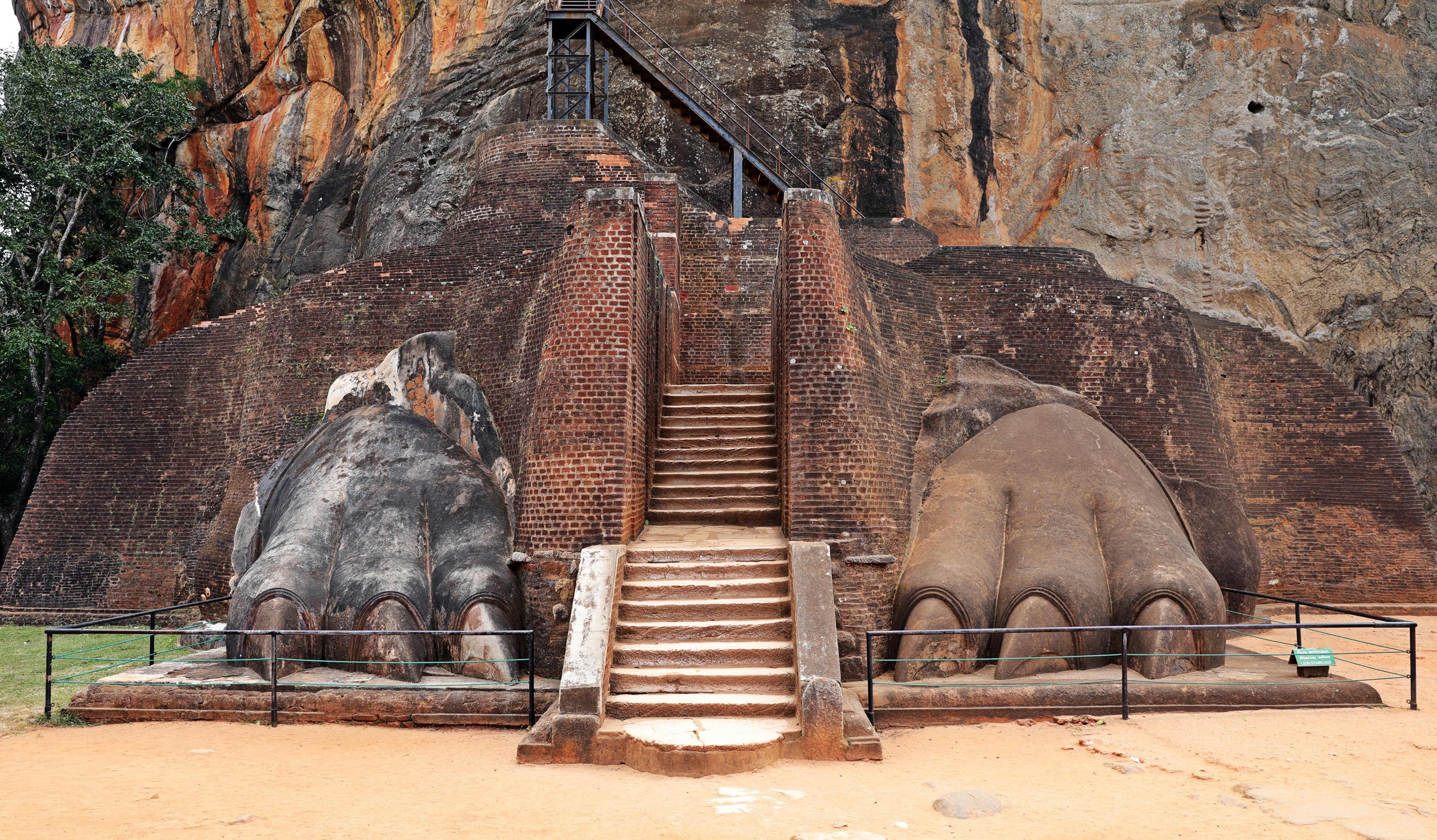
Lion’s Paws, Sigiriya Rock 
Sigiriya Rock wall with Water Garden far below
Above the paws is the large, flat summit where an immaculate palace once stood. Today it is just the ruins, but you can still get a sense of how immense the palace once was. Still intact is a large water tank and the king’s uncomfortable looking stone throne. The view of the water garden below is wonderful, and you can imagine the 5th century king standing up there, looking down admiringly on his palace grounds. There are also lovely views of the flat jungle below with high mountains in the distance. After the king was killed in a battle against his half-brother, the legitimate heir to the throne, the capital was moved back to Anuradhapura and the palace was re-converted to a monastery. By the 13th century, a 300-year drought meant that Sigiriya was abandoned and forgotten, left to being overtaken by the jungle.

Water tank and Palace ruins, Sigiriya Rock summit 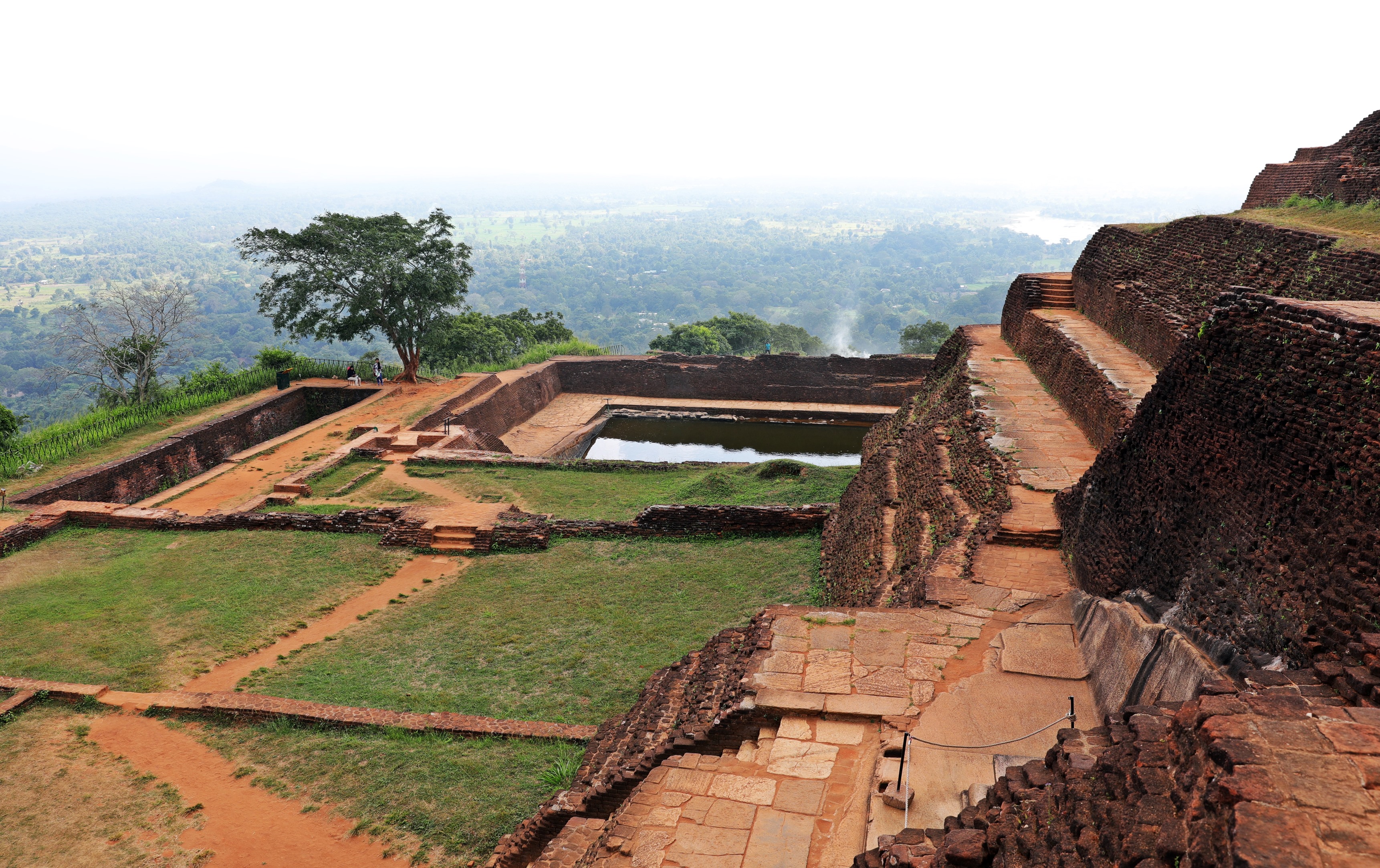
Water tank, Sigiriya Rock Palace 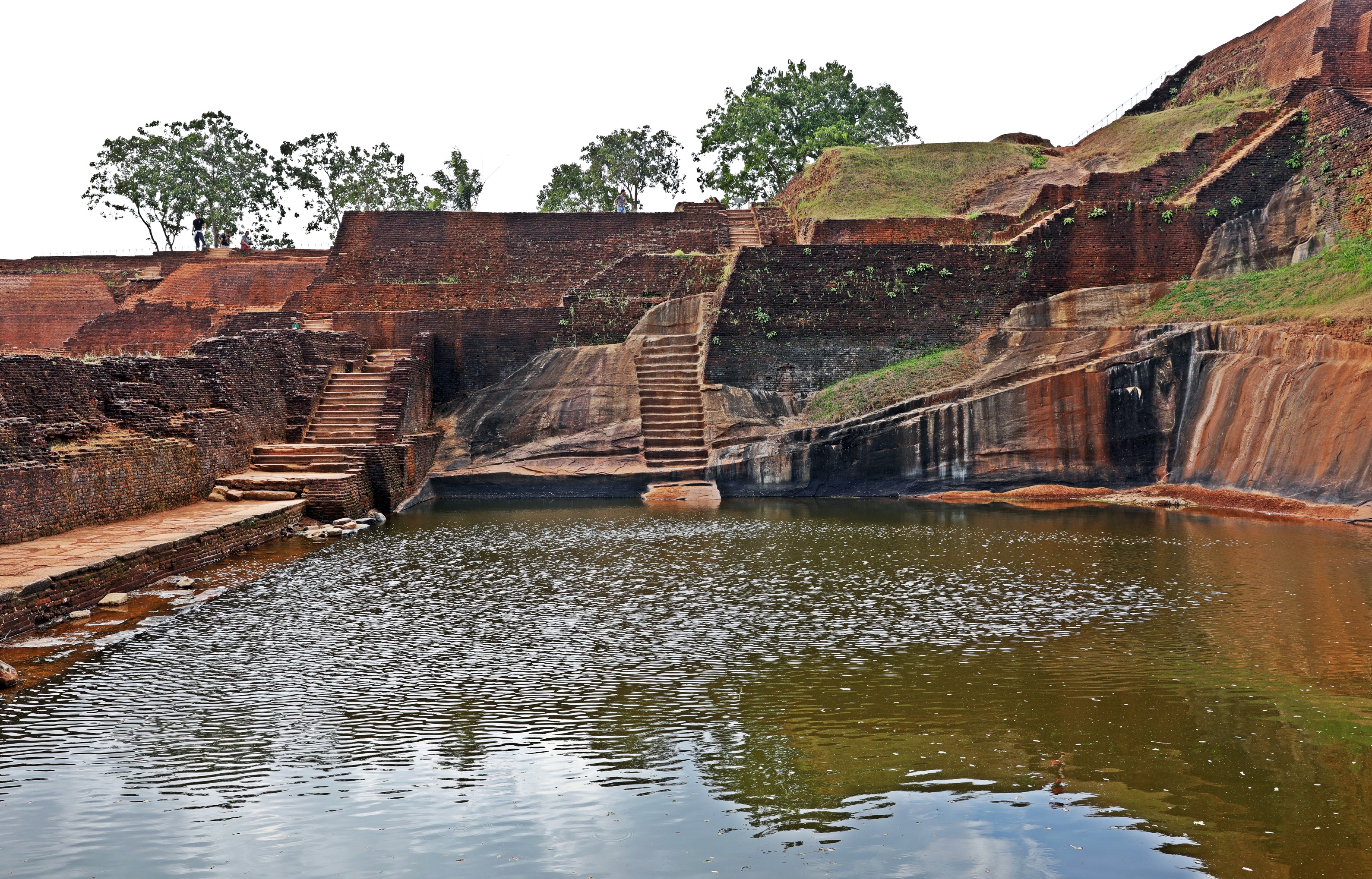
Water tank and palace ruins, Sigiriya Rock 
View of the Water Gardens from Sigiriya Rock summit 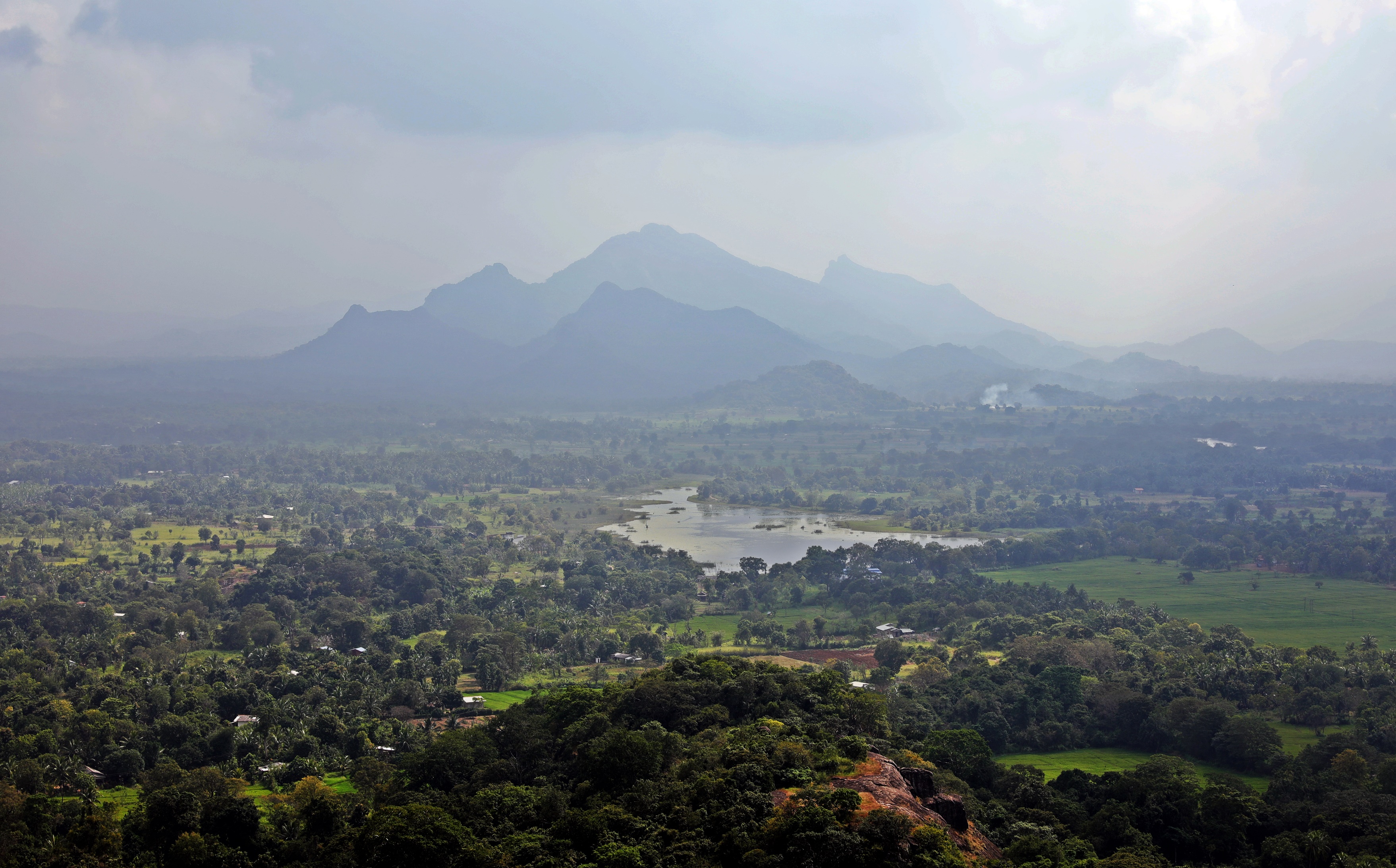
View from summit of Sigiriya Rock 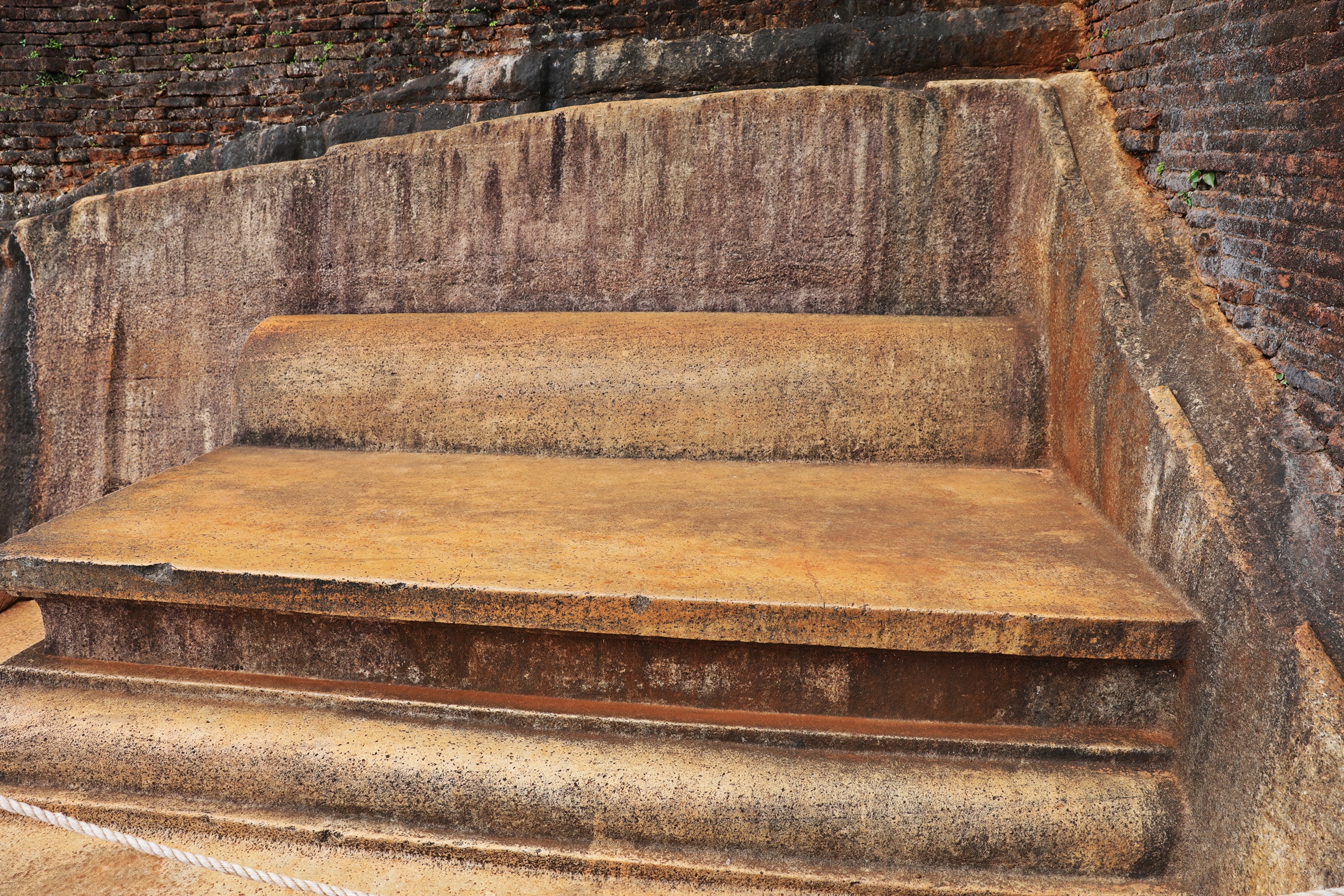
King’s Throne, Sigiriya 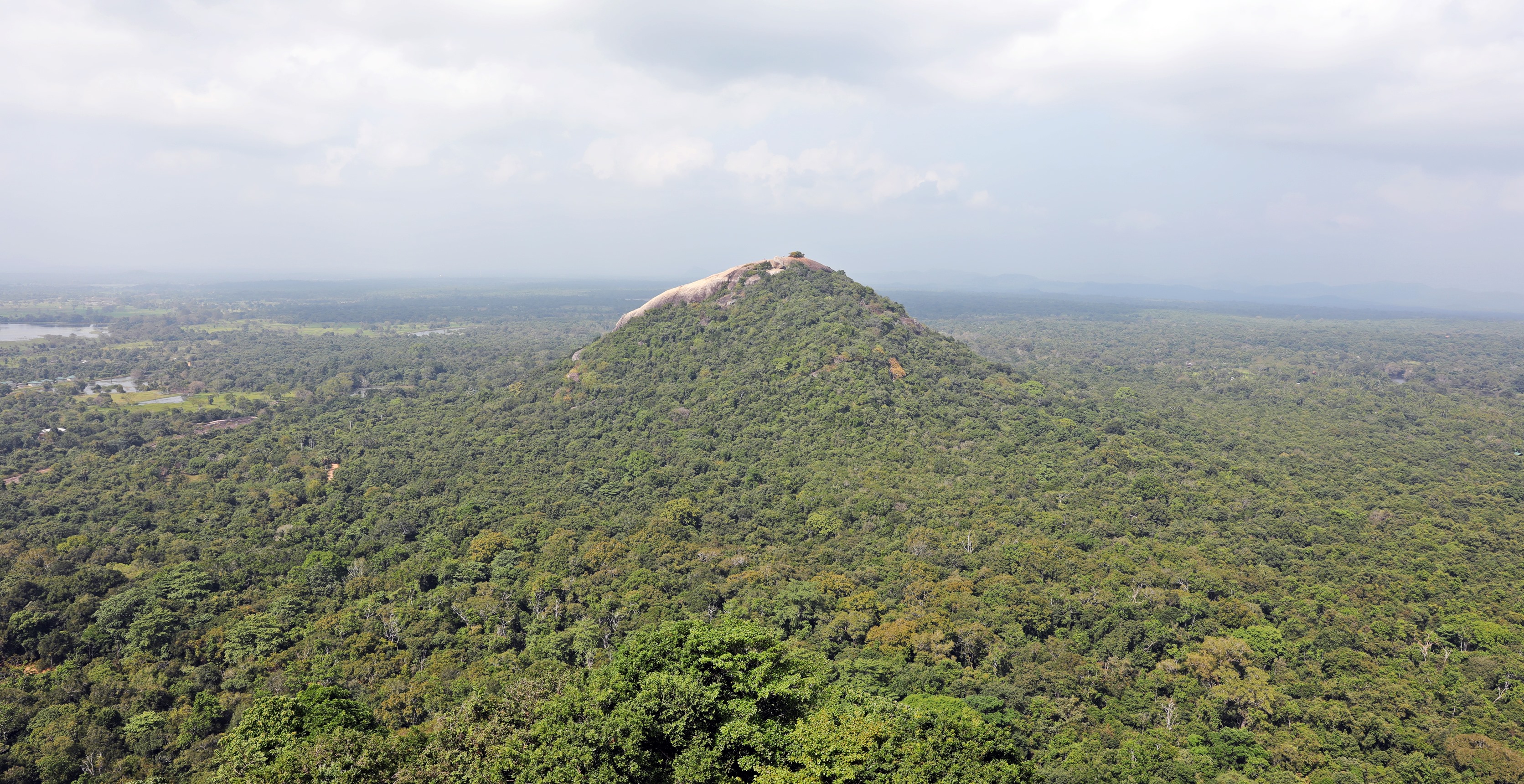
Pidurangala Rock
Pidurangala Rock was also created by a volcano and is a conical-shaped rock 1km away from Lion’s Rock. We hiked up to the top of Pidurangala Rock at sunrise. The hike begins at Rajamaha Viharaya, a cave temple where the transplanted monks from Sigiriya lived for a number of years. It’s a colourful cave with statues of Buddha and animals on the painted walls. Half way up Pidurangala, the hike passes a large brick, reclining Buddha from the 5th century. The top of the mountain is a rounded granite slab with little vegetation allowing a perfect 360° view of the jungle below. The best part though, is the view of Sigiriya Rock, sticking awkwardly out of the jungle. Trying to decide between Sigiriya and Pidurangala? Click here for a comparison of the two.

Elephant crossing sign, Sigiriya 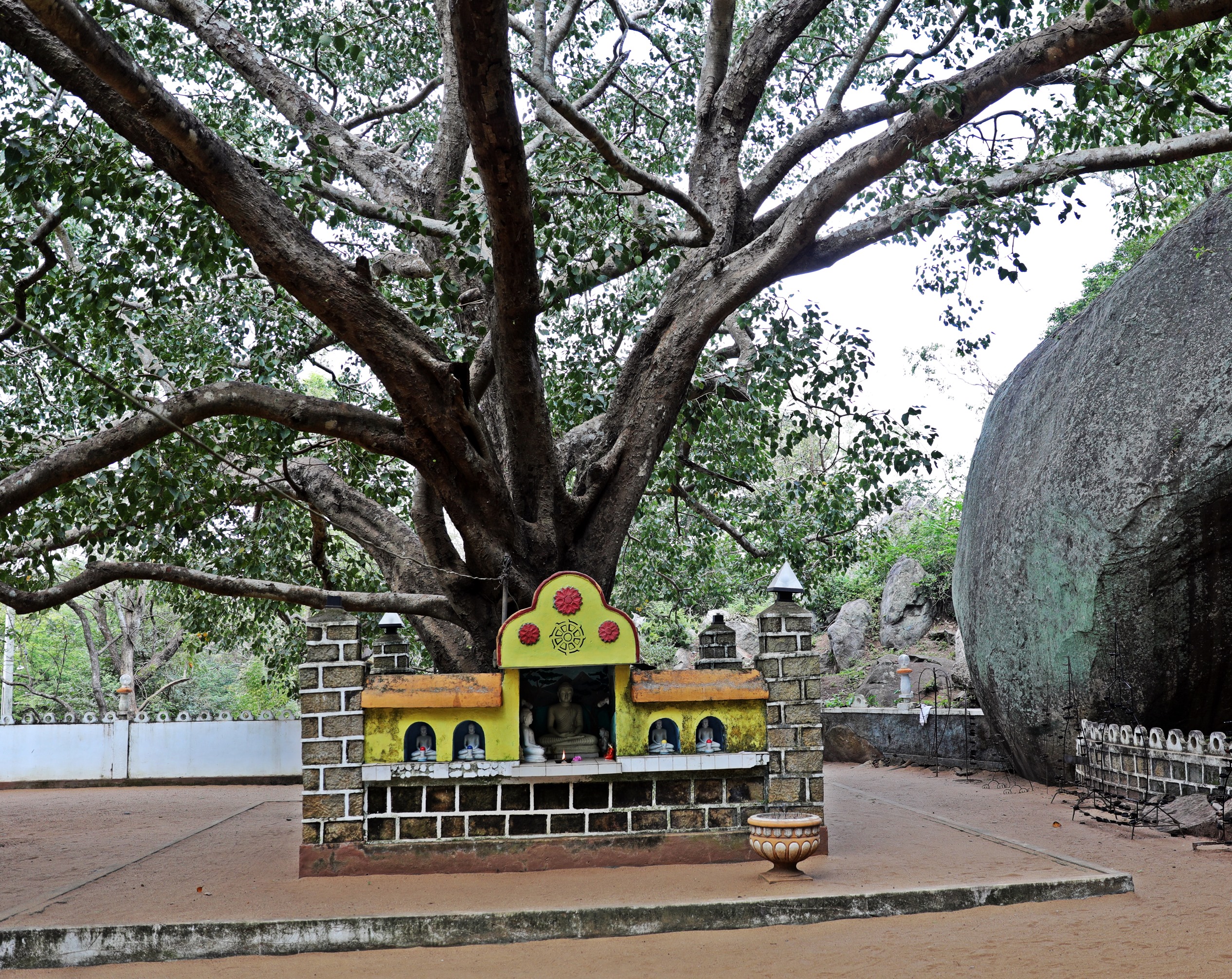
Pidurangala Rajamaha Viharaya Monastery 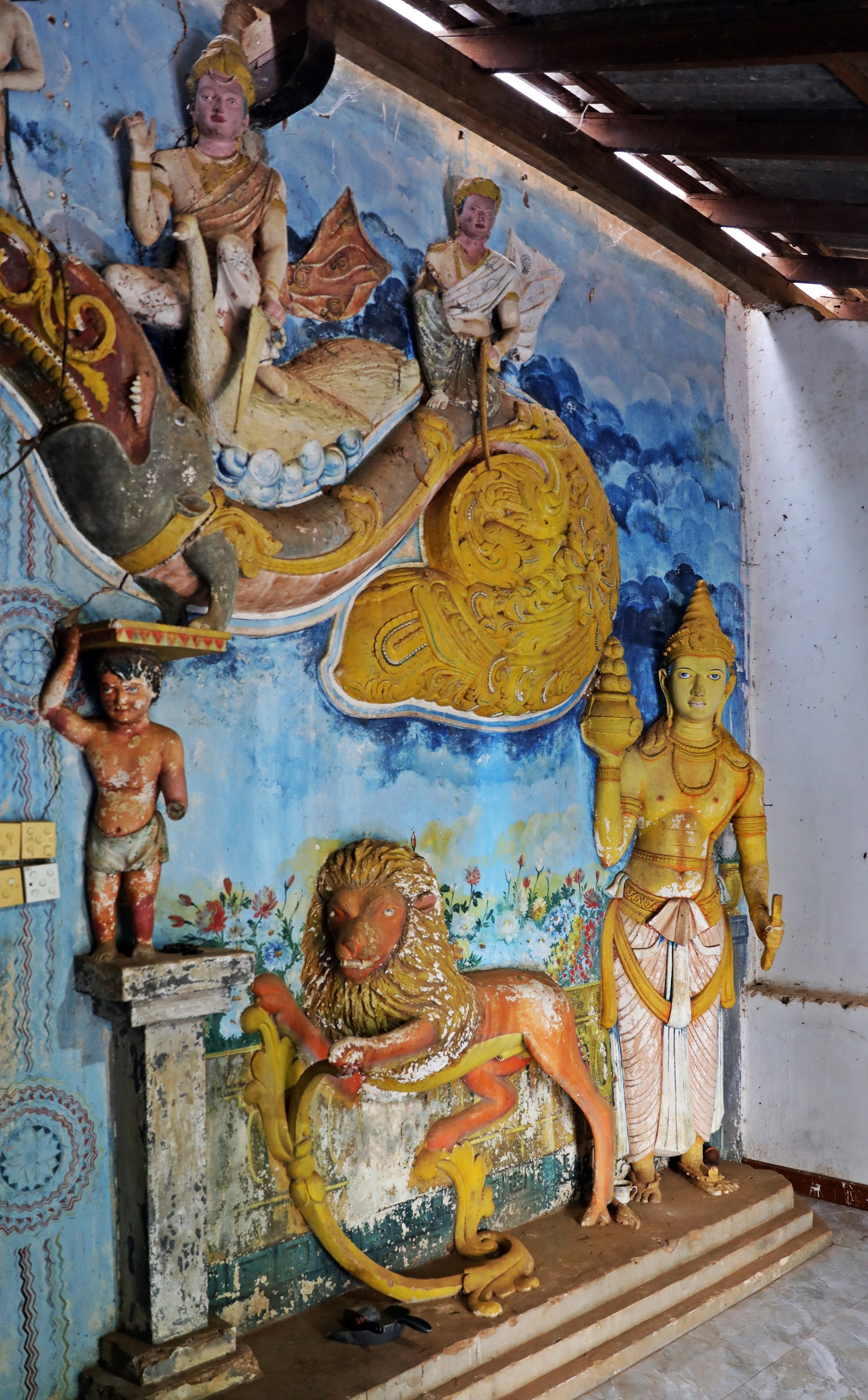
Pidurangala Rajamaha Viharaya Monastery 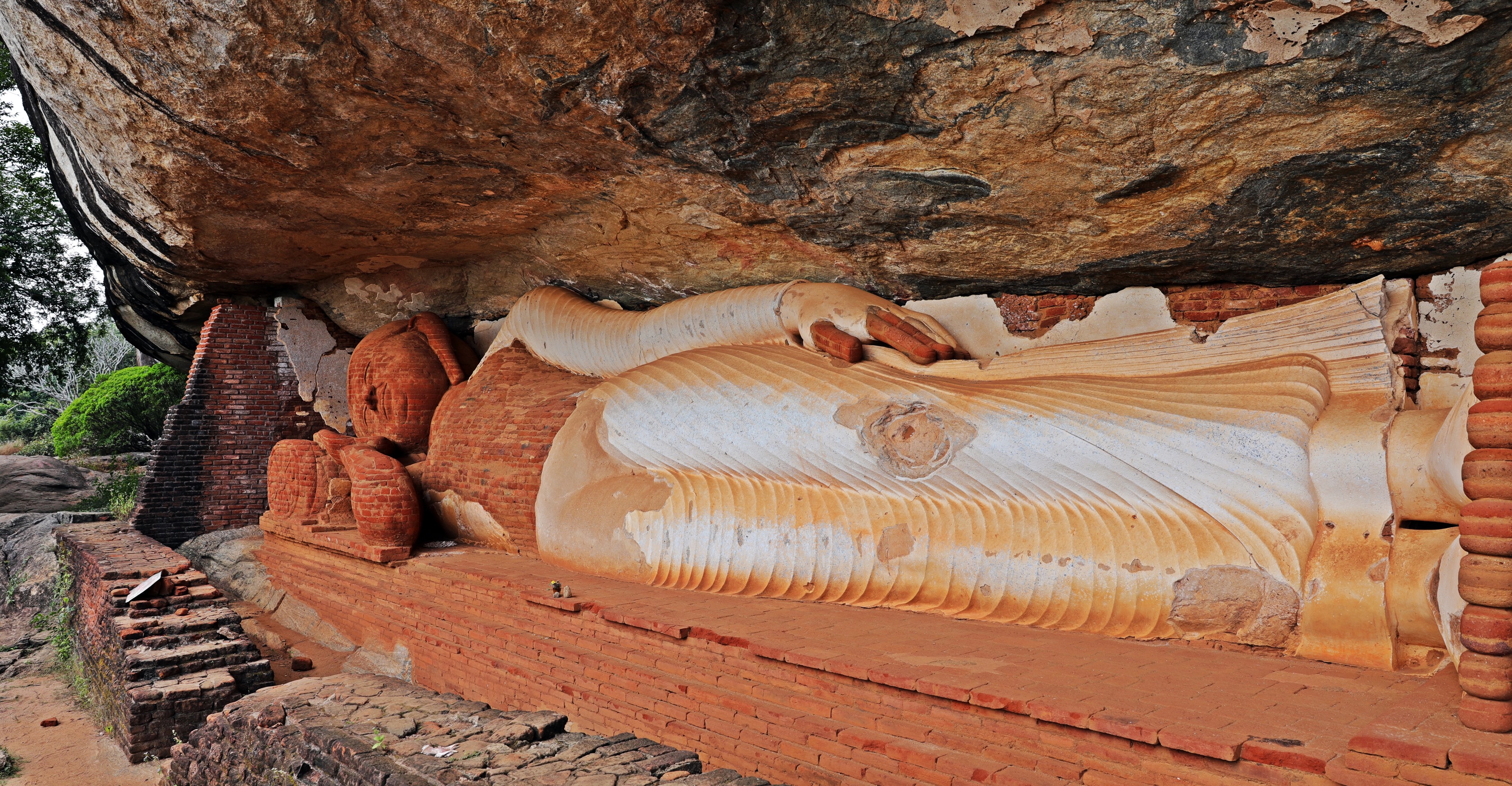
Reclining Buddha, Pidurangala Rock 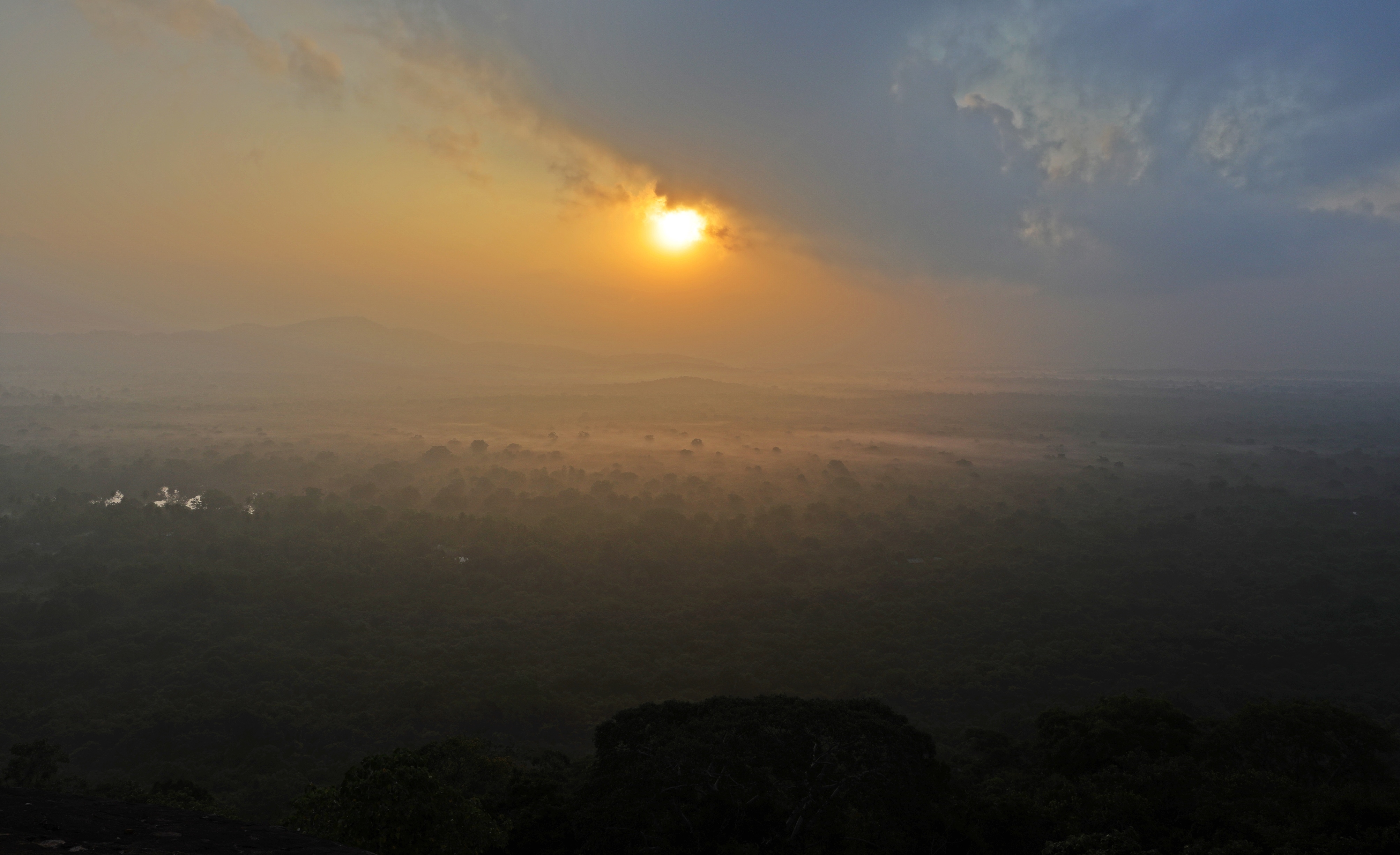
Sunrise with cloud forests below, Pidurangala Rock 
View of Sigiriya from Pidurangala Rock 
View of Sigiriya Rock from, Pidurangala Rock
The town of Dambulla is an hour away from Sigiriya. Royal Rock Temple is a complex with 5 ancient temple caves in a small rocky hill outside of town. The first cave was made into a temple over 2000 years ago. Subsequent ones were added over the next few hundred years. Each one is filled with Buddha statues in all poses. There are over 150 Buddhas between the 5 small caves as well as dagobas (stupas) and statues of the kings. The walls and low ceilings have gorgeous frescoes of Buddha and lotus flowers in bright colours. The caves are very impressive due to the sheer number of statues and the details in the paintings. At the base of the hill is a new, flashy monastery with a large golden Buddha on its roof. It seemed a bit out of place after the gorgeous artwork in the caves above.

Royal Rock Temples, Dambulla 
Royal Rock Temples, Dambulla 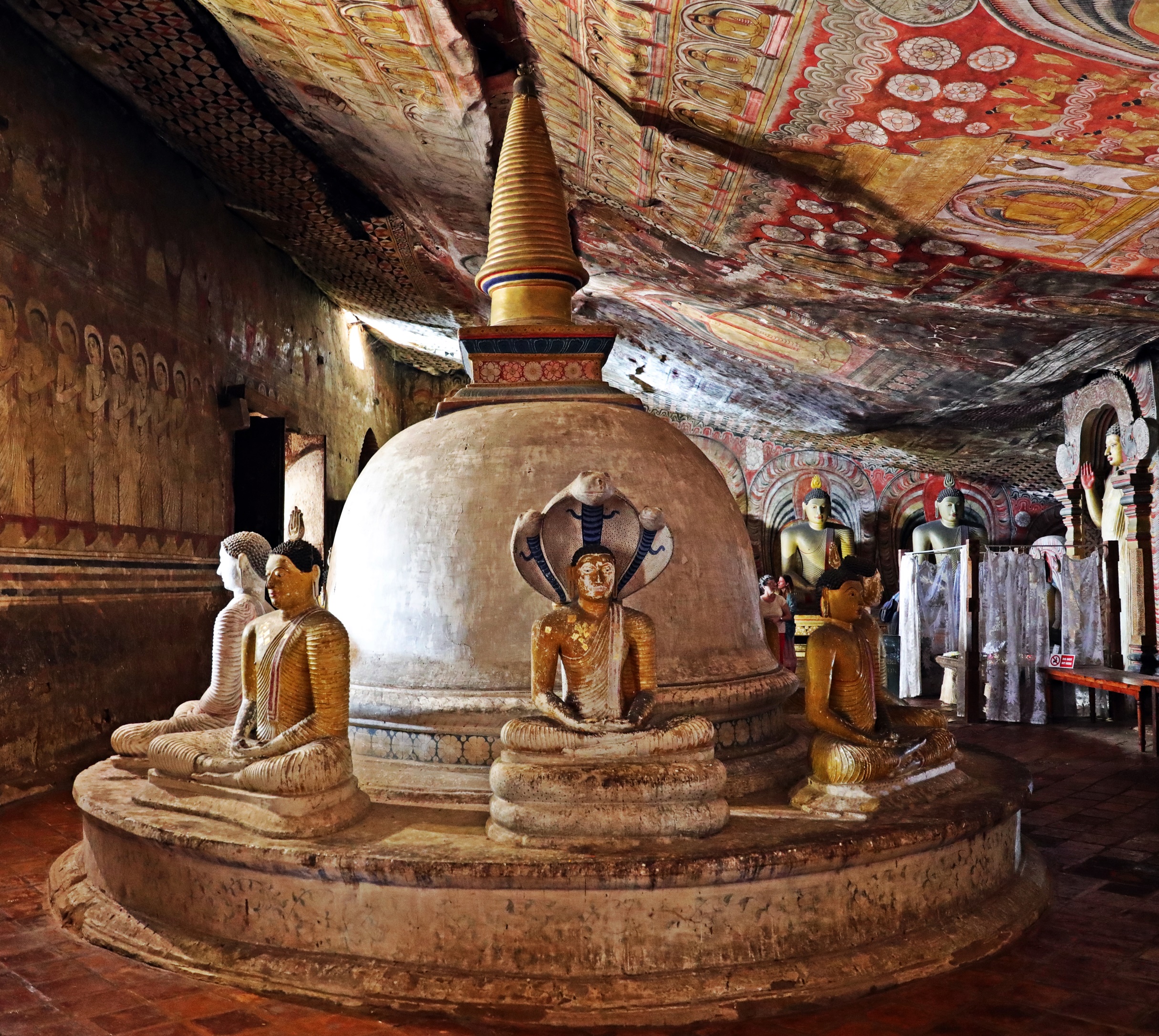
Royal Rock Temples, Dambulla 
Royal Rock Temples, Dambulla 
Royal Rock Temples, Dambulla 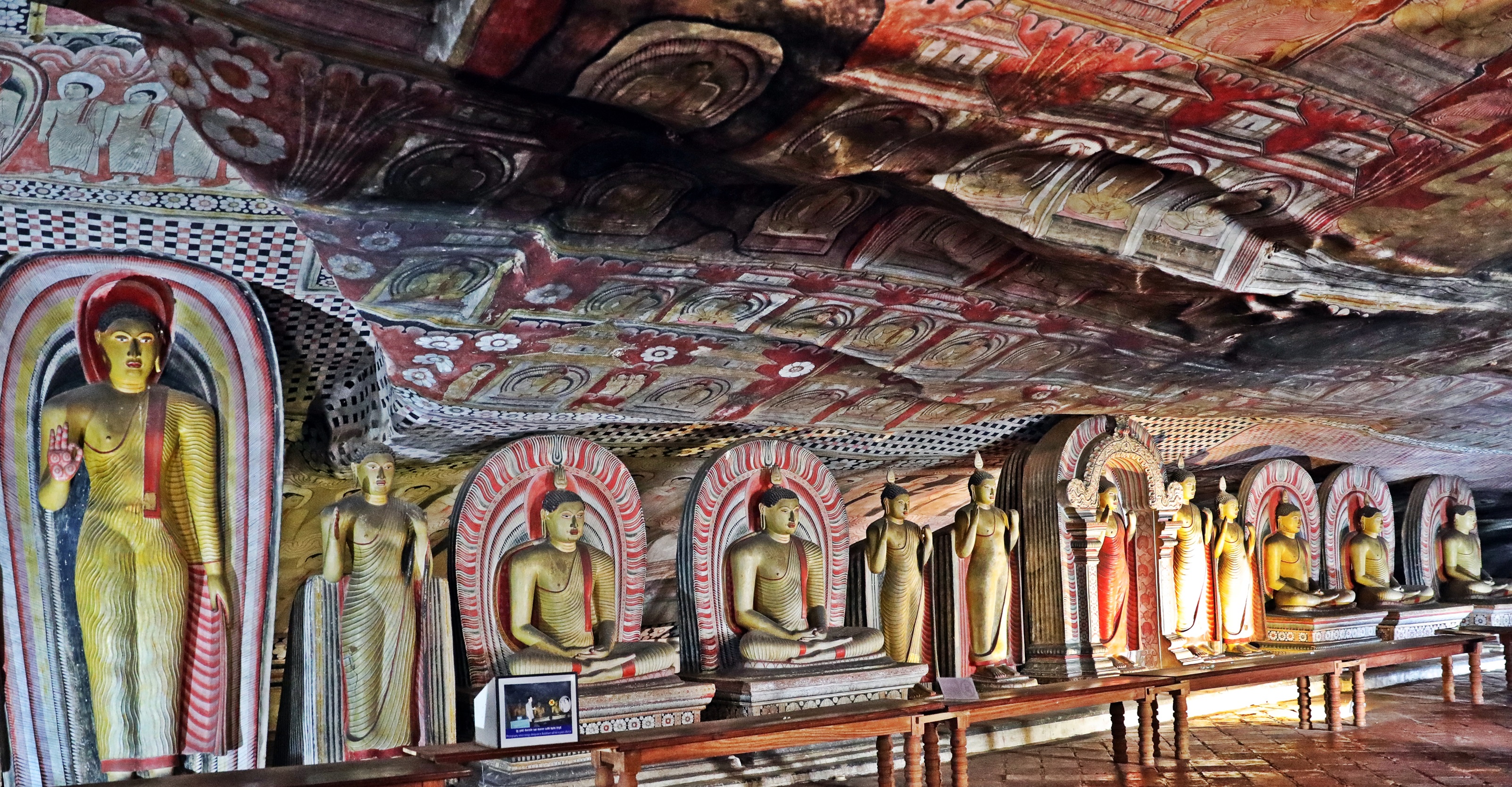
Royal Rock Temples, Dambulla 
Royal Rock Temples, Dambulla 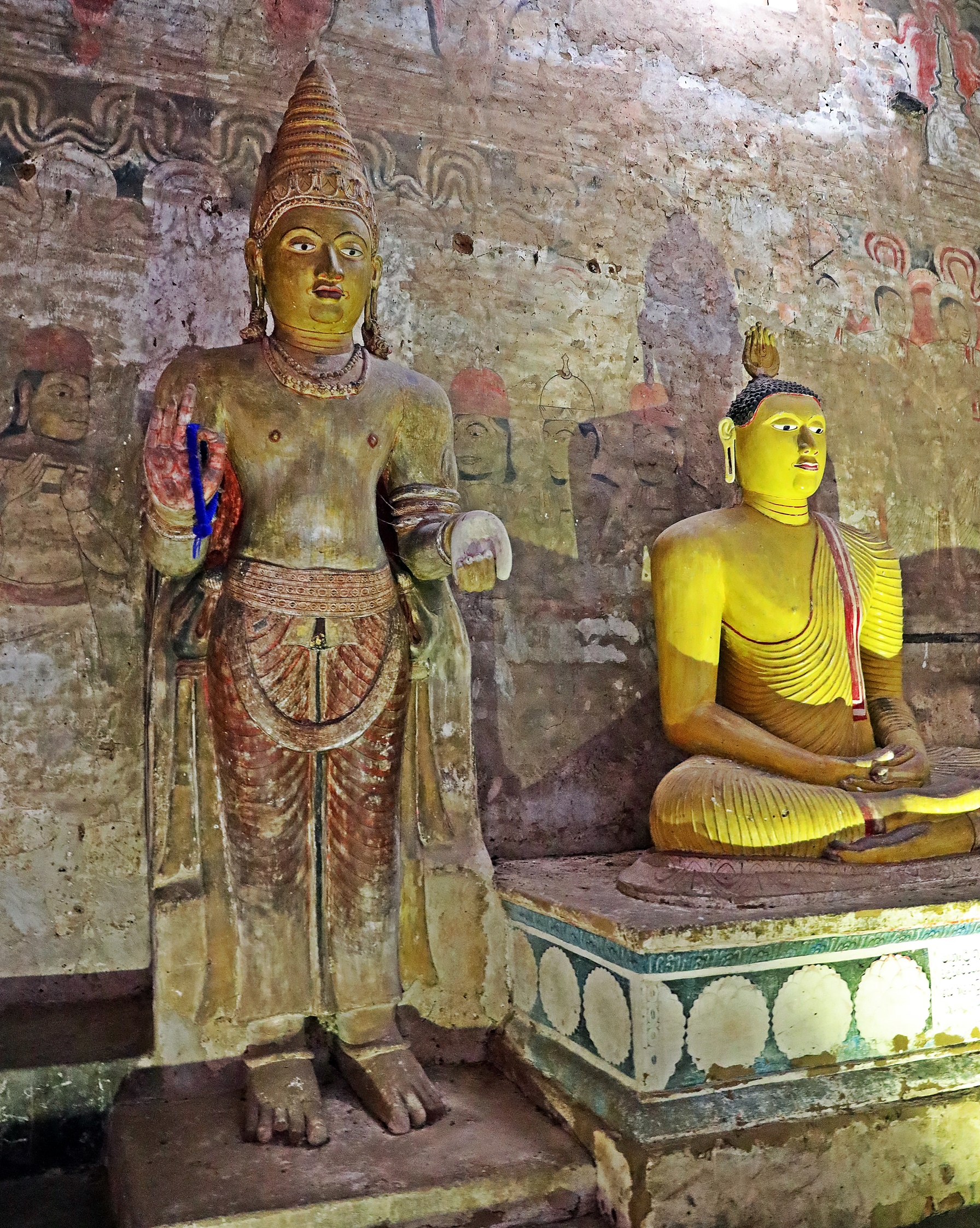
Statue of a king, Royal Rock Temples, Dambulla 
Royal Rock Temples, Dambulla 
Royal Rock Temples, Dambulla 
Golden Temple, Dambulla
Sixty km away, the ancient city of Polonnaruwa was a capital city for approximately 300 years beginning in the 12th century when the capital was moved to Polonnaruwa from Anuradhapura (watch for an upcoming blog). Today the ruins of the ancient city are spread over a few kilometers. The site is so large that we rode old-school bicycles to get between the ruin sites. Alahana Pirivena was a large 12th century monastery covering 35 hectares. The ruins of hundreds of monk’s cells, dagobas (stupas) and even a monastic hospital are surrounded by a tropical forest. One of our favourite parts were the crocodile water spouts sticking out of the brick walls. The old dagobas and brick walls are now covered in moss making them appear more mysterious. At the centre of this large complex is a large white dagoba called Kiri Vihara Dagoba. Beside it is Lankatilaka Image House. You can still see the tall brick walls and long narrow hallway that leads to a giant, now headless, Buddha. It’s a breathtaking site. The outer walls and entrance gates are magnificently detailed with sculptures of lions and guardians.
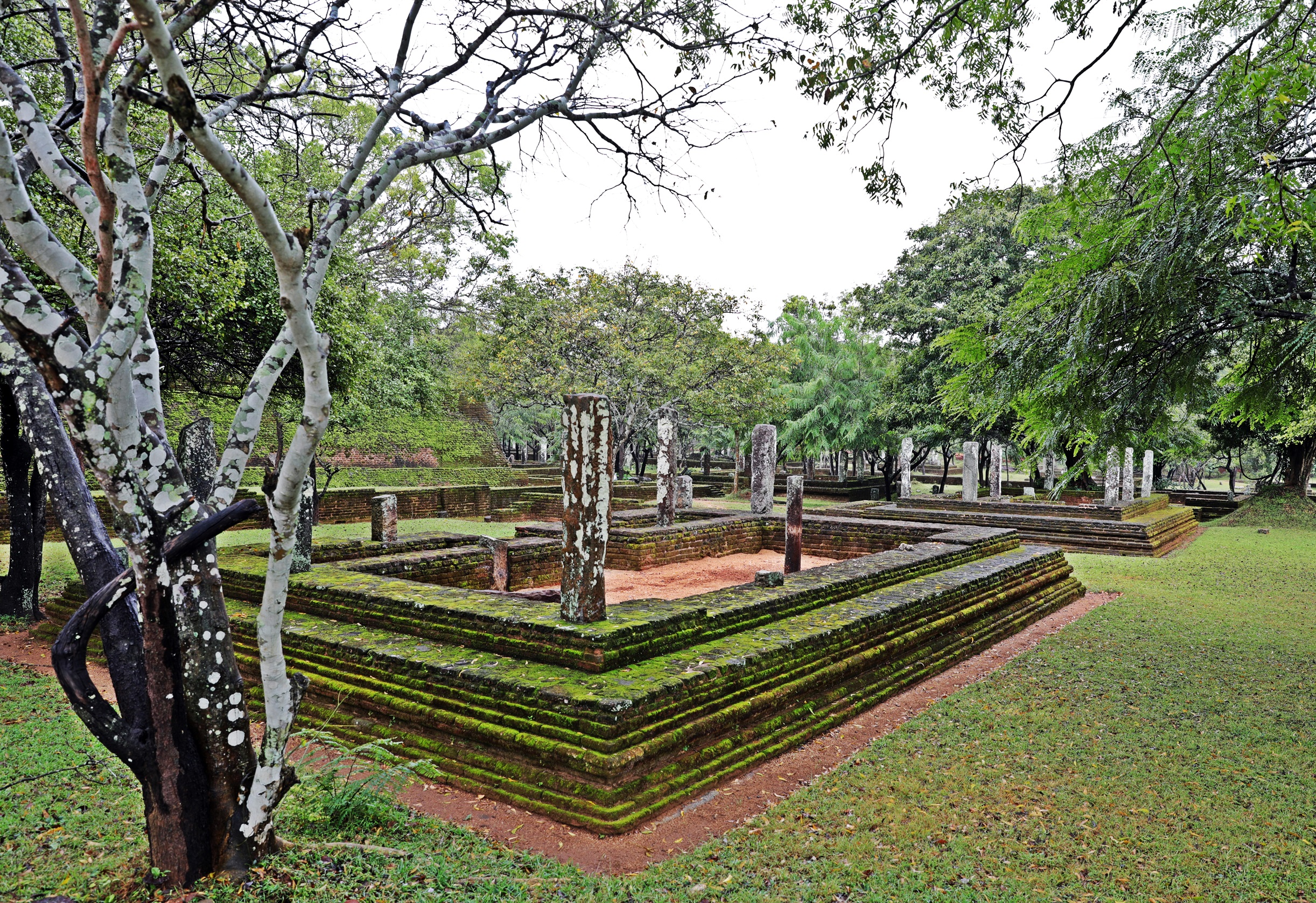
Mossy ruins, Alahana Pirivena Monetary, Polonnaruwa 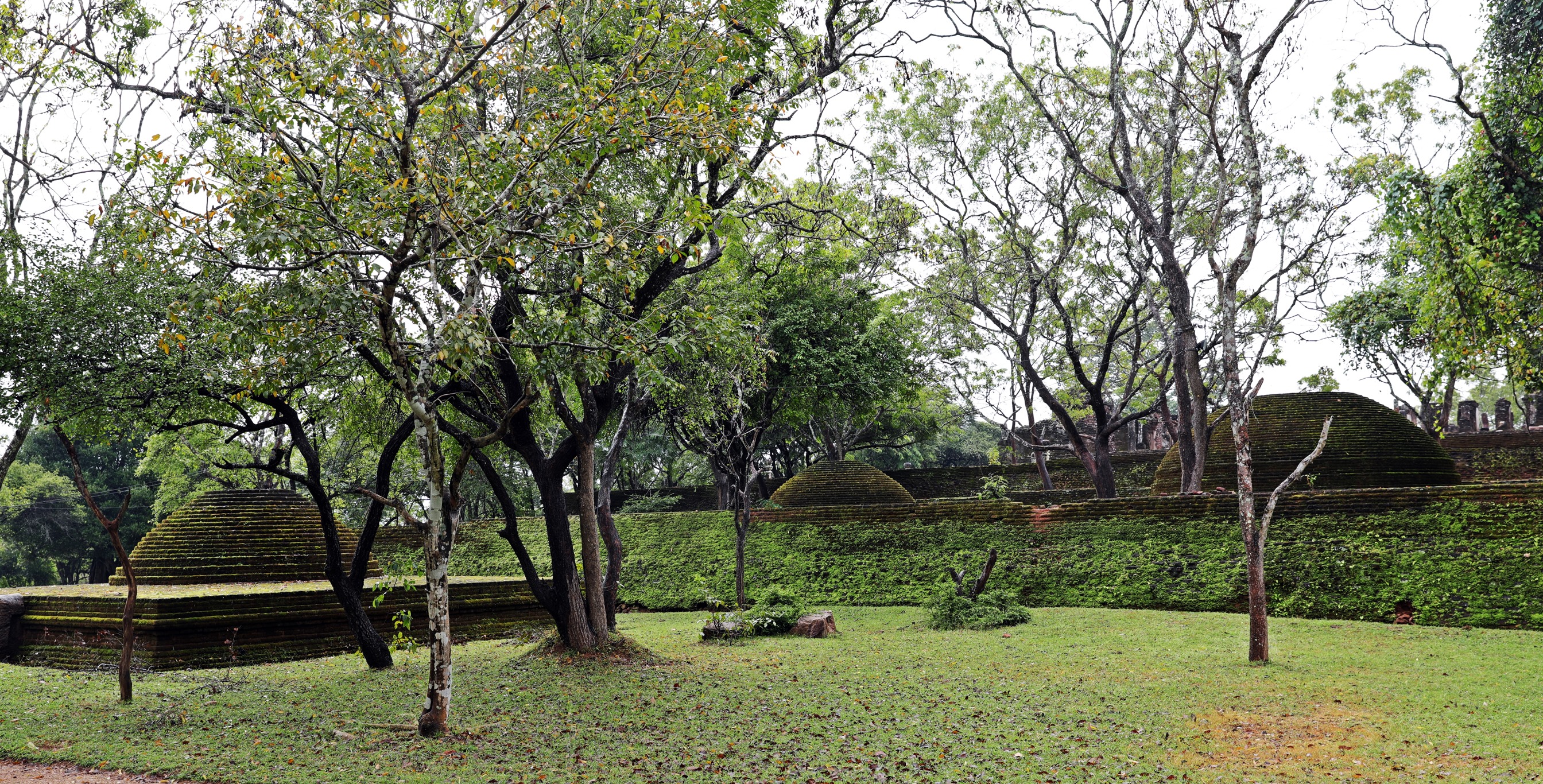
Mossy ruins, Alahana Pirivena, Polonnaruwa 
Strangler Fig growing through the brick wall, Alahana Pirivena 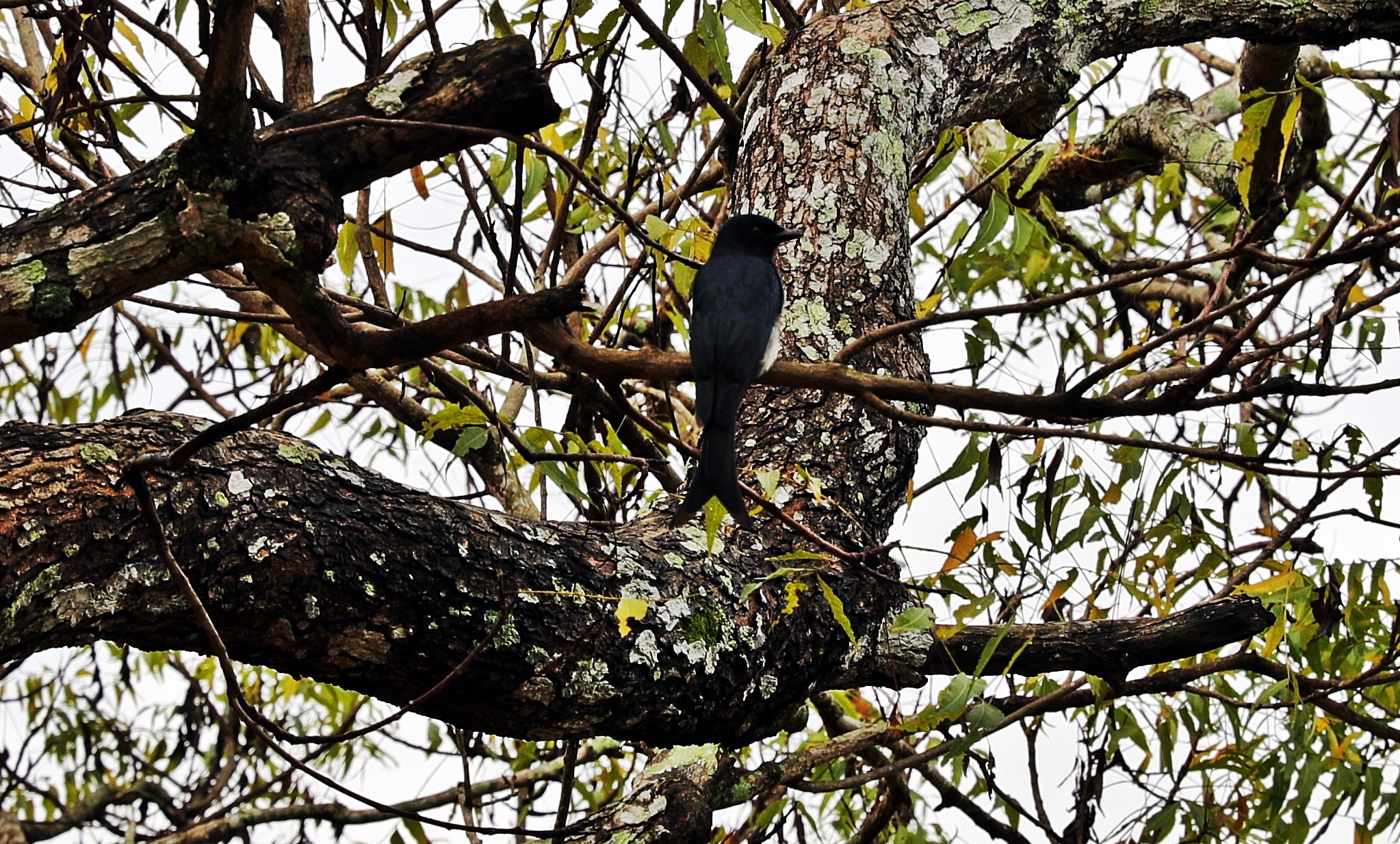
Endemic Sri Lankan Crested Drongo, Alahana Pirivena 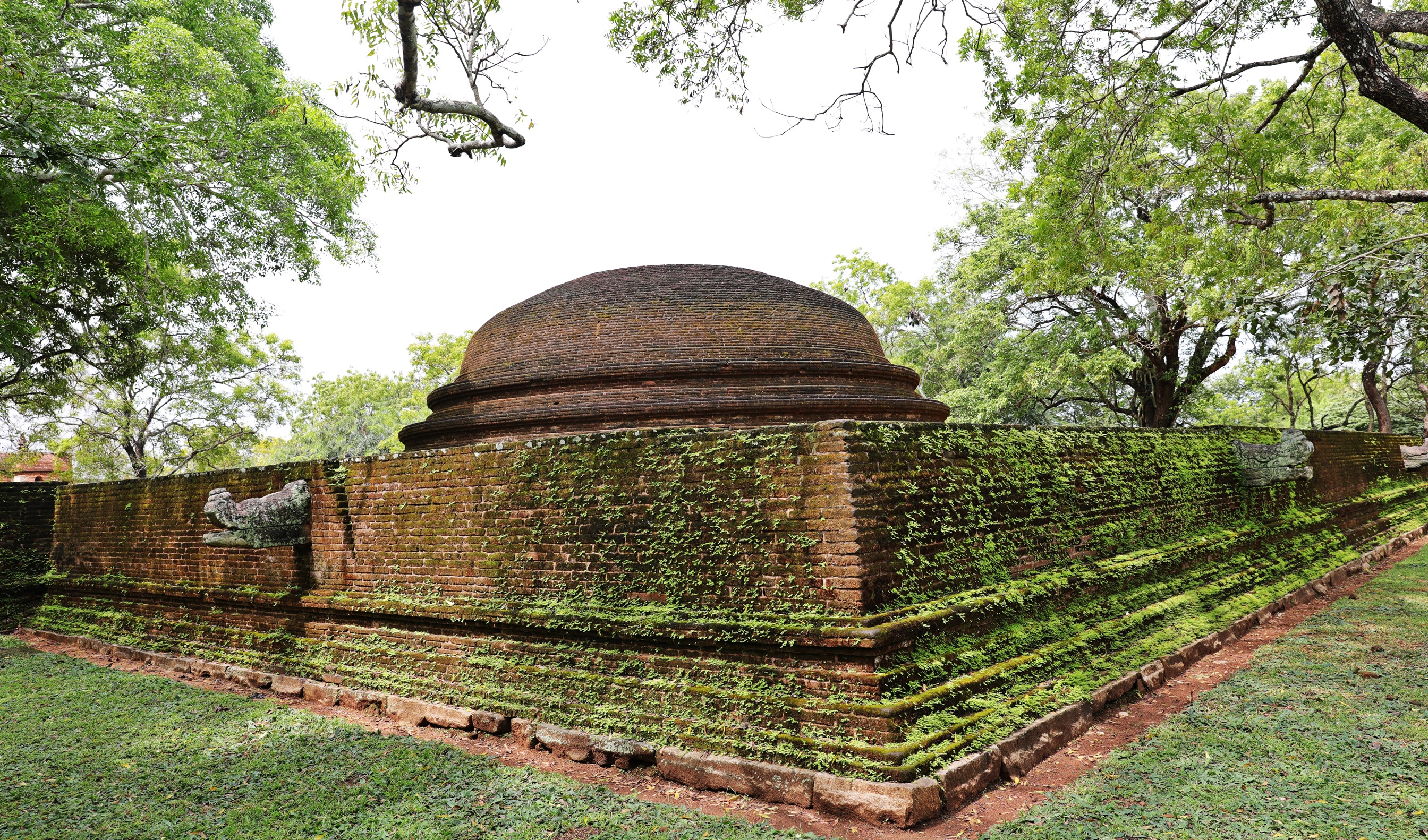
Crocodile spouts, Alhana Pirivena Monastery 
Alahana Pirivena Monastery, Polonnaruwa 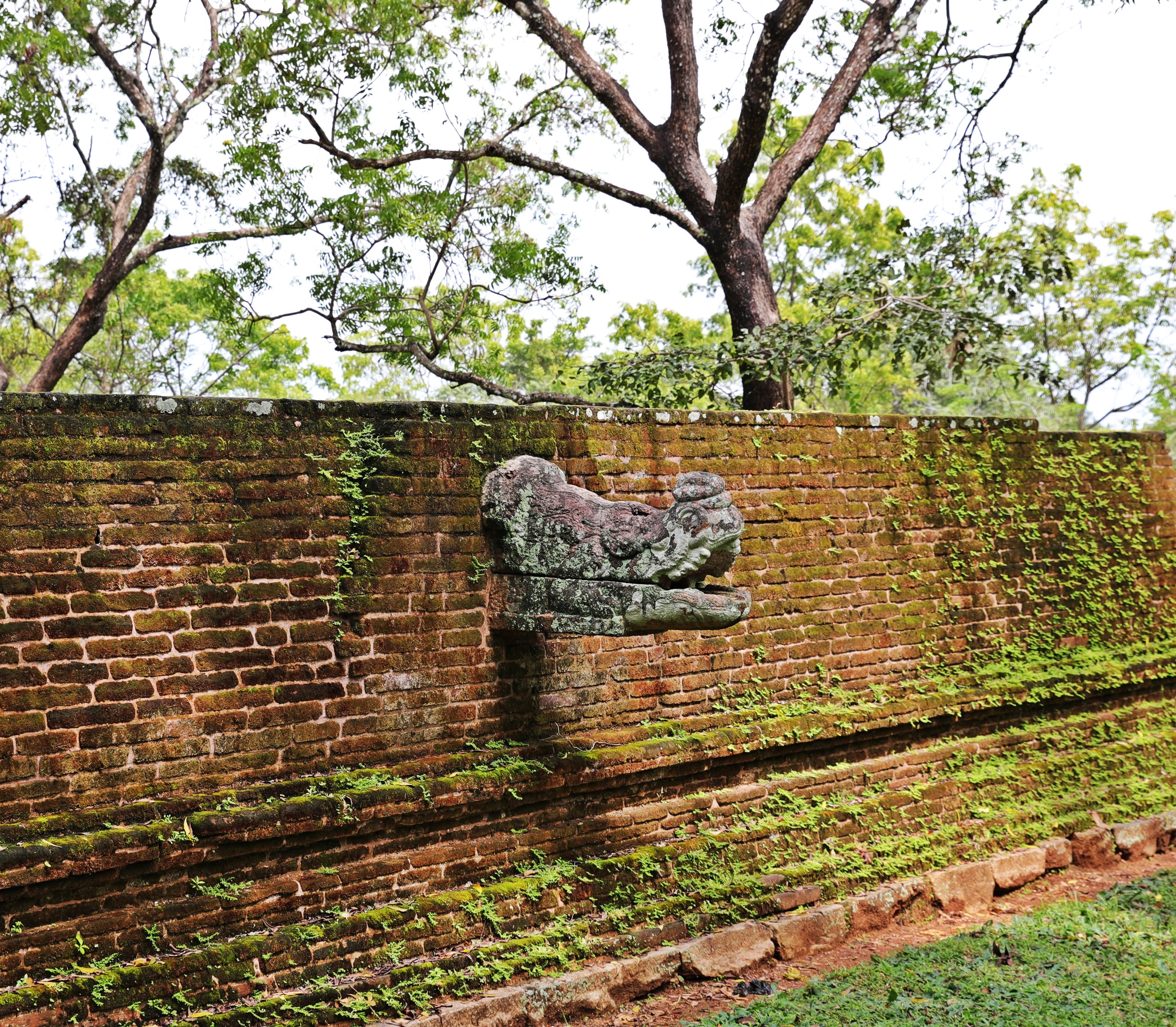
Crocodile spout, Alhana Pirivena Monastery 
Kiri Vihara Dagoba, Polonnaruwa 
Lankatilaka, Polonnaruwa 
Headless Buddha,Lankatilaka, Polonnaruwa 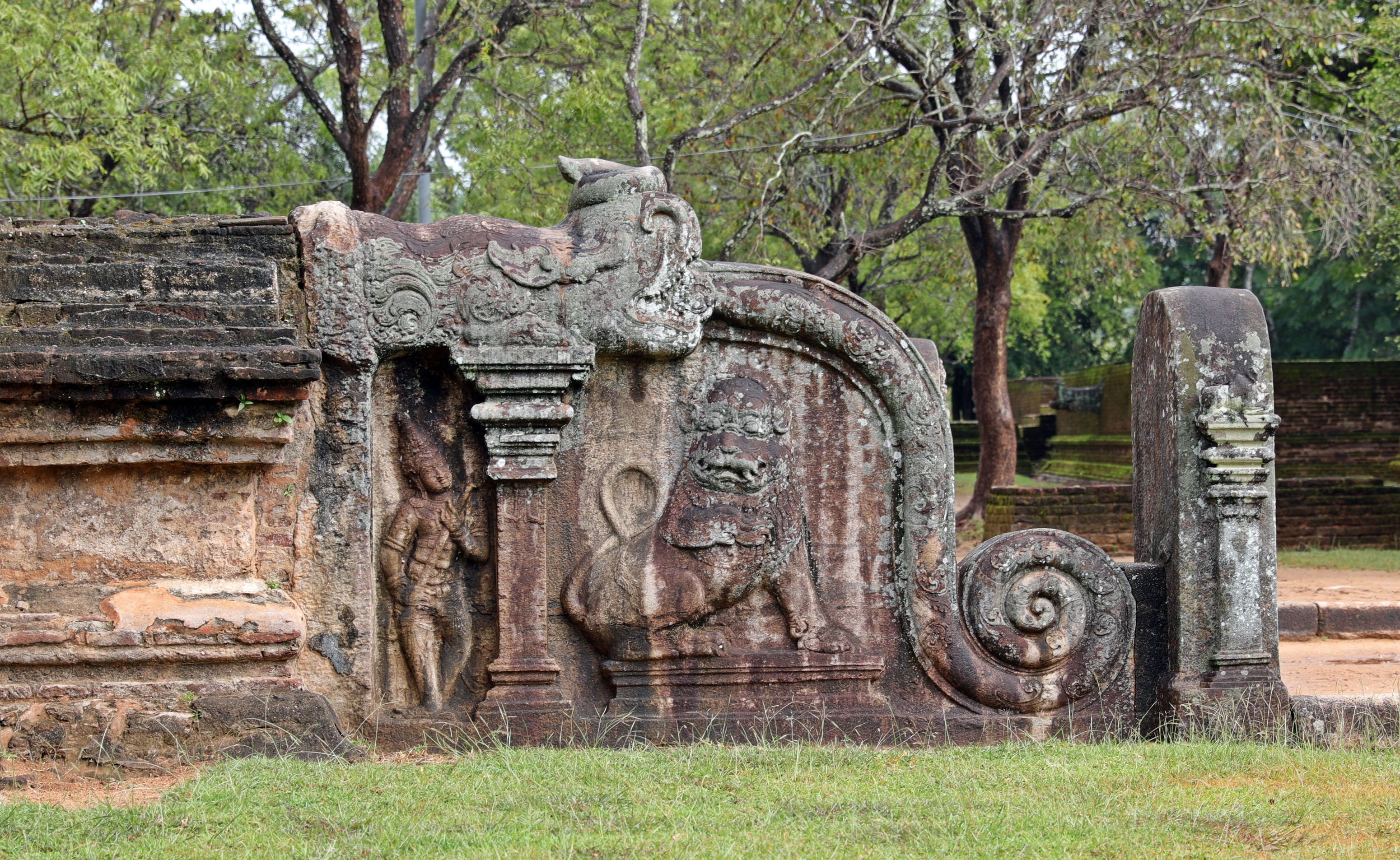
Lankatilaka, Polonnaruwa 
Monkey massage, Polonnaruwa
Across from the monastery is the 12th century carvings of Gal-Vihara. Four impressive Buddha statues were carved from a large slab of granite. The posture and facial expression of the standing Buddha makes him look like he has a bit of an attitude, and we love the way the lines of the granite go across his face like war paint. There is a bit of controversy about this carving as it is an unusual posture for Buddha. Some say it is not Buddha but one of his disciples. The details that went into all these sculptures show the skill of the carvers in the 12th century.

Reclining and Standing Buddhas, Gal Vihara, Polonnaruwa 
Standing Buddha, Gal Vihara, Polonnaruwa 
Standing Buddhas, Gal Vihara, Polonnaruwa 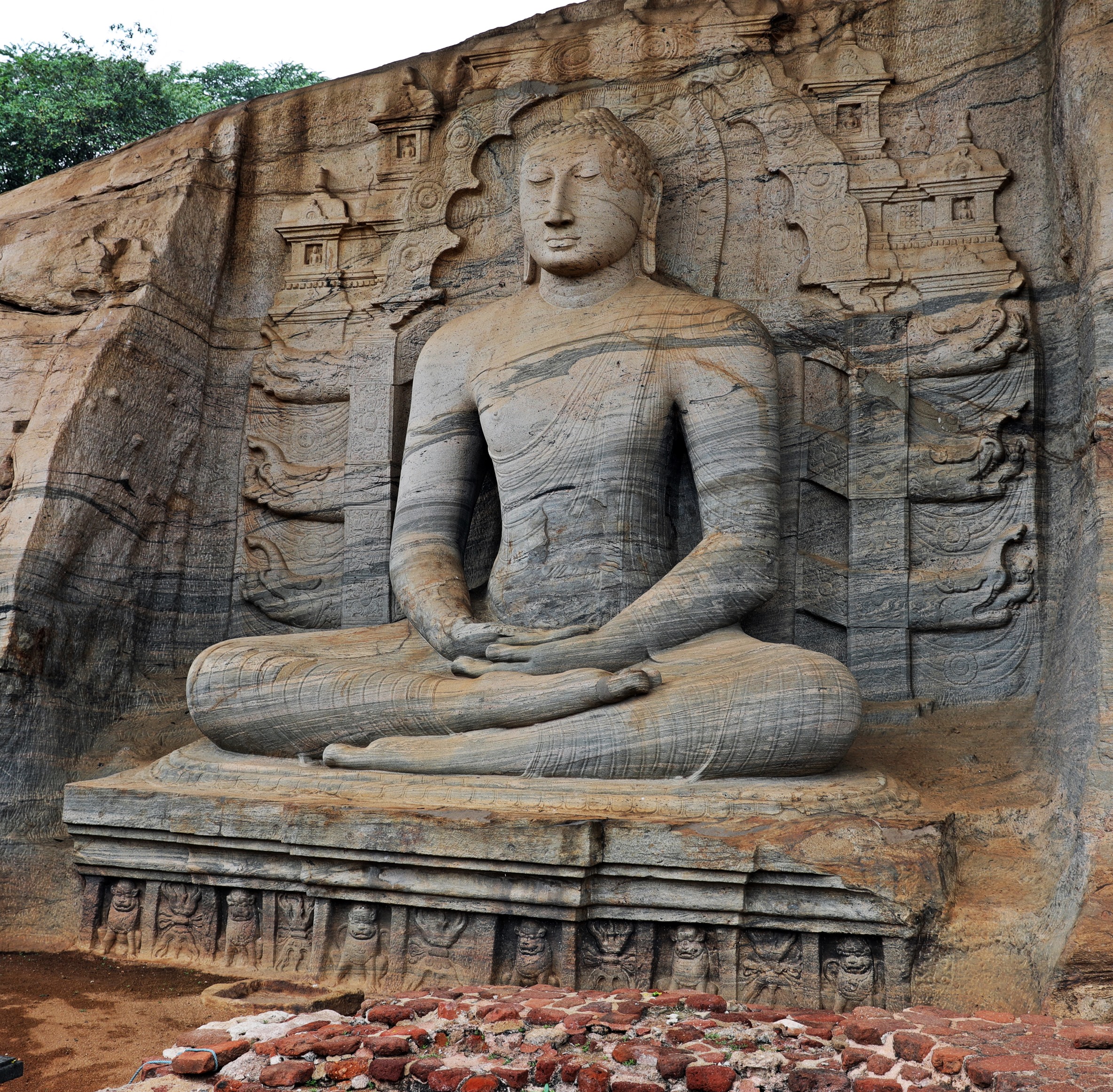
Sitting Buddhas, Gal Vihara, Polonnaruwa 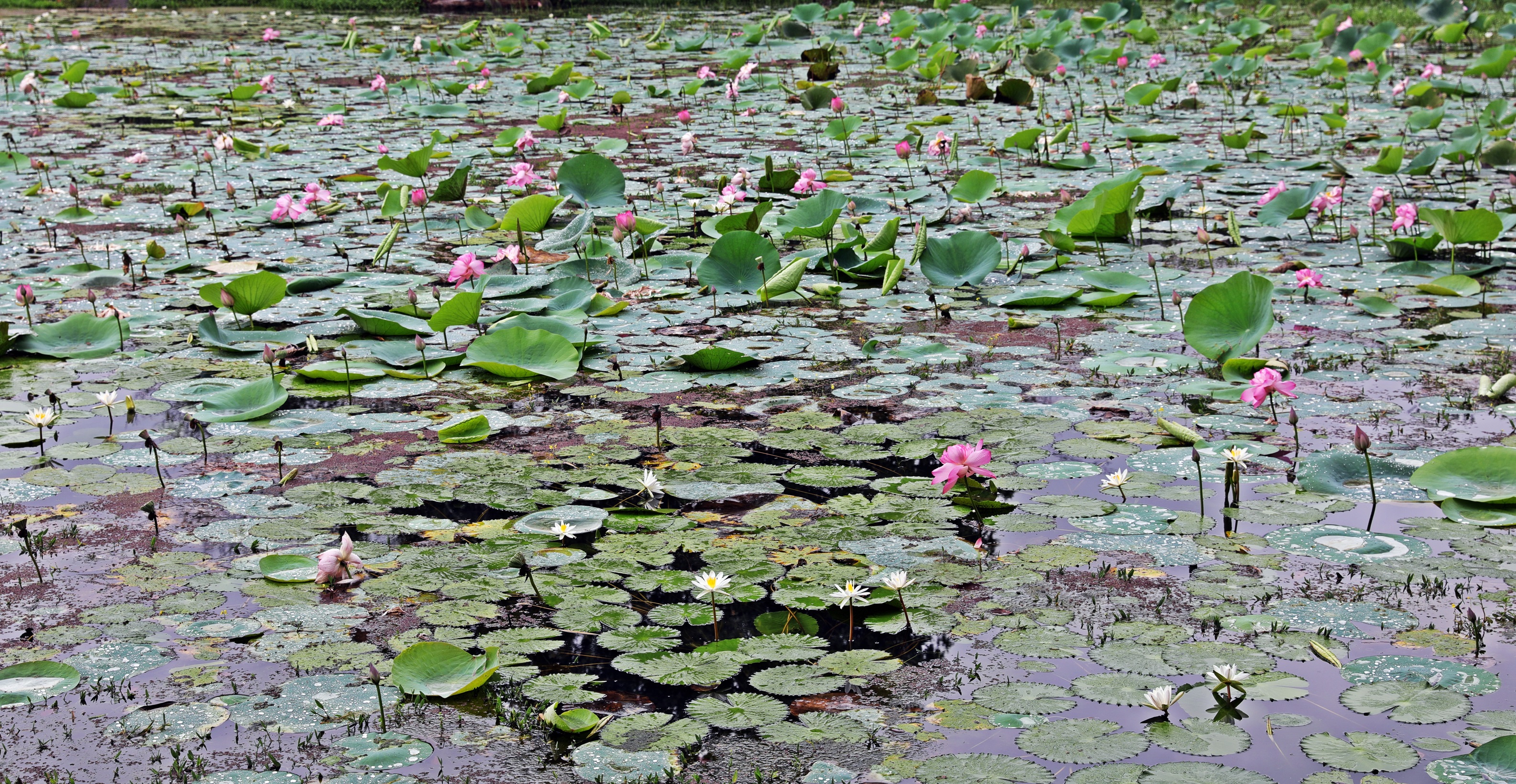
Lotus Pond, Gal Vihara, Polonnaruwa
A kilometer away is an area called the Quadrangle where there are several ruins in a confined space. Vatadage is an interesting round structure with outer and inner walkways. It is believed that the Buddha Tooth Relic was kept here in the 12th century. It has four entrances each with a small set of steps and Buddha statues facing out. At the base of the steps were beautifully carved moonstones with depictions of elephants, horses and ducks. Another ruin, Latha-Mandapaya, is a collection of stone pillars carved as lotus stems. The king used to sit in this hall and listen to Buddhist monks chant mantras.
A sudden downpour started as we were about to enter the Quadrangle. We took shelter under a nearby tin shack while we watched a troupe of Toque Macaques running into one of the temples for protection. We watched them jump from tree to tree and scale the brick wall of the temple to reach an open window or door to get inside. It’s fitting that there were so many monkeys here as this was the location for Disney’s film ‘Monkey Kingdom’ which is the story of Toque Macaques. We’ll have to watch it when we get home.

Vatadage, Polonnaruwa 
Buddhas and dagoba inside Vatadage, Polonnaruwa 
Moonstone at entrance of Vatadage 
Lotus stalk pillars, Latha-Mandapaya 
‘Monkey Kingdom’ Temple, Polonnaruwa 
Baby Toque Macaque, Sigiriya 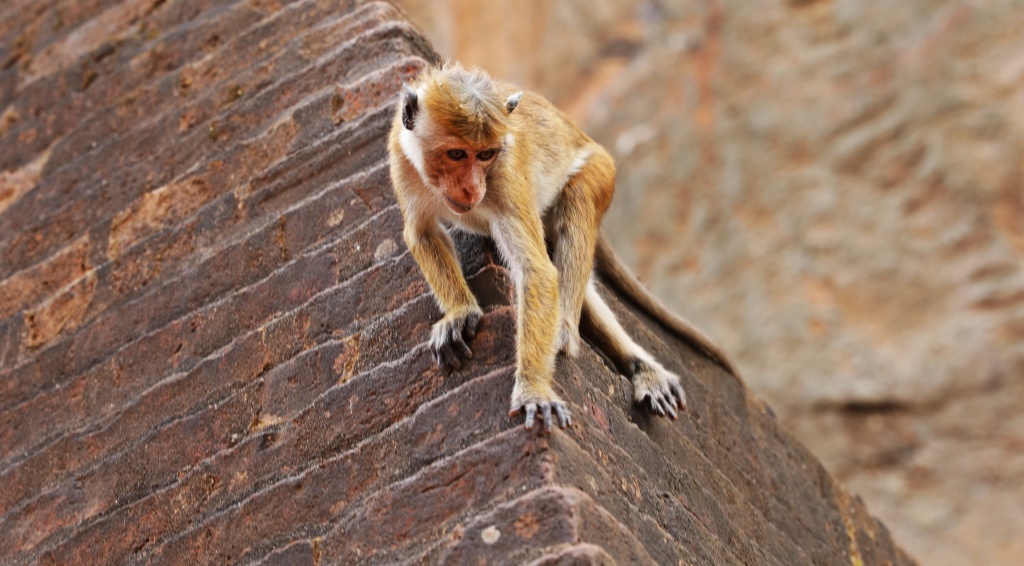
Macaque climbing on the ruins, Sigiriya Rock
Further down the road in is the Royal Palace. There are only a few walls remaining of the Palace which used to be an incredible 7 stories tall. The palace’s Audience Hall has wonderful details. Along the side of the hall’s base is a frieze of elephants and funny dwarfs. There are two large stone lions guarding the entrance.

11th century Palace ruins, Polonnaruwa 
Lions at the entrance to Audience Hall, Polonnaruwa 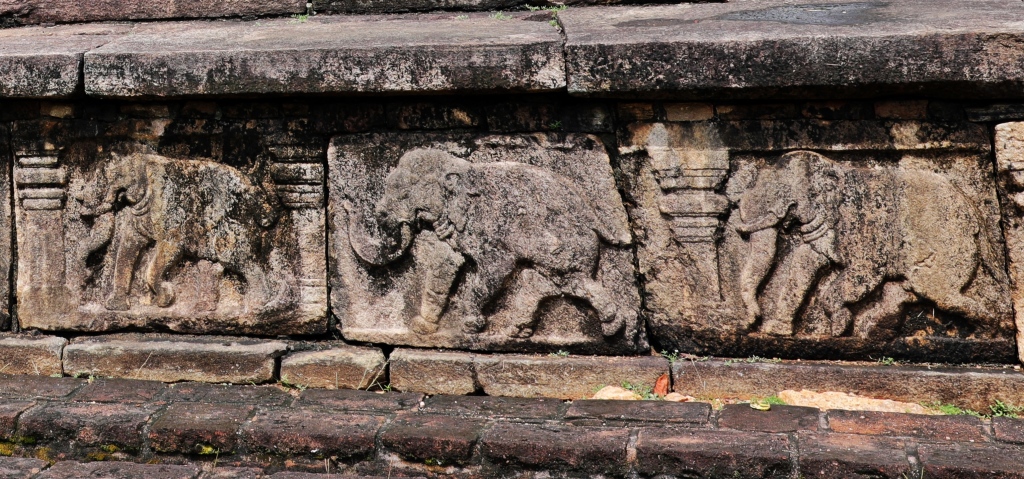
Elephant frieze on Audience Hall’s outer wall, Polonnaruwa 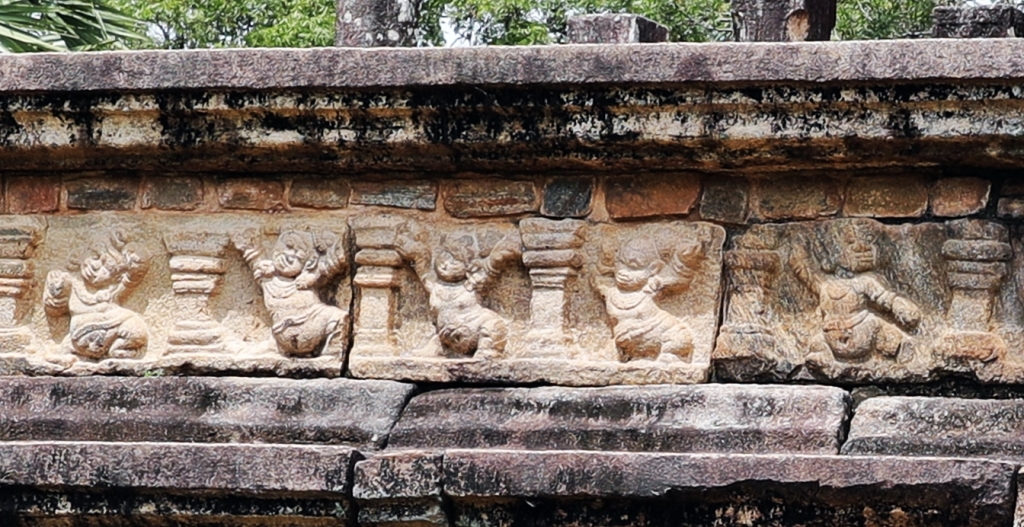
Carvings on Audience Hall’s outer walls, Polonnaruwa 
Pabula Vihara, Polonnaruwa 
Pabula Vihara, Polonnaruwa 
12th century palace ruins near Parakrama Samudra Lake
At one brick enclosed pond near the exit, we saw a family of Grey Langurs with their long eyebrows. One baby was so cute as it was still quite uncoordinated, but was practicing climbing trees, and jumping on and off the steps.

Old brick Pond, Polonnaruwa 
Look at those eyebrows, Grey Langur 
Baby Grey Langur learning to climb 
Mongoose outside our hotel, Polonnaruwa
Coming up next: Sri Lanka’s East Coast Beaches
For extra pics from this trip go to Gallery/Sri Lanka. For extra pictures from other blogs go to Gallery at monkeystale.ca
To read about more of our adventures go to Destinations.
If you like what you read, please comment or share it using the links below.
Amazing travel! Makes me want to go there. Thanks!
LikeLiked by 2 people
You should!! It’s a remarkable country with so many different things to do and very easy to get around.
LikeLiked by 1 person
I’ve been to Sri Lanka twice, and every time I went I always visited Sigiriya, Dambulla, Polonnaruwa and Anuradhapura. For a relatively small country, Sri Lanka does have an impressive collection of ancient monuments. I remember getting slightly nervous when I climbed the metal stairs at Sigiriya in 2012. Three years later fortunately things had improved.
LikeLiked by 2 people
Sri Lanka is remarkable. I didn’t notice anything scarey on the stairs so they mist have improved them since you were last here. Thanks for reading!
LikeLiked by 2 people
Again, amazing post and pictures! Make me want to book the next tix to Sri Lanka and immerse in its rich and diverse culture and history. 🙂
LikeLiked by 2 people
Thanks Carl! It is a great place for a holiday…..
LikeLiked by 1 person
Wonder whether there is anything you have or will not see in Sri Lanka! Great pictures!
LikeLiked by 2 people
This is such a comprehensive and beautiful post. The walk through the boulder arch and view down to water garden are stunning, as are the exquisite cave temples at Dambulla. The rock striations on the standing Buddhas are wonderful and I think I’d go to Polonnaruwa just for those cute monkeys alone. Cool that you saw a mongoose (hope he keeps the snakes at bay). I have all these places on our list!
LikeLiked by 2 people
Thank you so much Caroline. Now I hope you’re not expecting to much, but we liked this area more than expected. Unfortunately we saw at least 10 mongooses (?mongeese?) in Sri Lanka and even more snakes which terrify me!
LikeLiked by 1 person
Alright, now I’m scared. I’m fine with spiders but am the biggest chicken even with the tiniest garter snake. I’ll have to get Mike to lead our walks/hikes😫
LikeLiked by 1 person
I’ll tell you where some of them are then. There are 3 snake charmers on the tourist side of Kandy Lake, one behind Cobra Rock on Sigiriya. You have to go by it but if he knows you don’t like them he’ll put it in the bag. They all did that when they saw my reaction – Which is to run away:) There’s one by the big lake in Colombo that I heard about but didn’t see. The only 2 wild ones were in Bentota lagoon pointed out to us by the guide and one in the grass on the TOP (!?) of Sigiriya. Thankfully there were none on the safaris.
LikeLiked by 2 people
Thanks for the heads up. I have read other accounts of snakes at Sigiriya and will be extra vigilant (and anxiety-ridden). I probably shouldn’t be thinking of this right before I turn in for the night😱. No more snake talk.
LikeLiked by 2 people
I always like ancient monuments! Thank you for sharing!
LikeLiked by 1 person
Thank you for reading 😊
LikeLiked by 1 person
My pleasure!
LikeLike
Your photos are amazing! I was in Sri Lanka about a year and a half ago, and I just felt that wave of nostaligia coming back! How long were you there for?
LikeLiked by 1 person
Thank you! We love Sri Lanka. We were thrre for just over 2 months. It was nice to have that long so we could see almost everything.
LikeLike
The mirror wall image at Sigiriya is incorrect. Beyond the Sigiriya frescoes, the path clings to the sheer side of the rock and is protected on the outside by a 3m-high wall. This wall (not the actual rock face) was coated with a smooth glaze upon which visitors felt impelled to note their impressions of the women in the gallery above.
LikeLike
Oh, that’s not what we were told. I’ll delete that section then since I’m not sure where the 3m high wall was.
LikeLiked by 1 person
From this link, you can get an idea about mirror wall. Best wishes and Happy travelling https://panique.com.au/sigiriya/sigiriya-mirror-wall.html
LikeLike